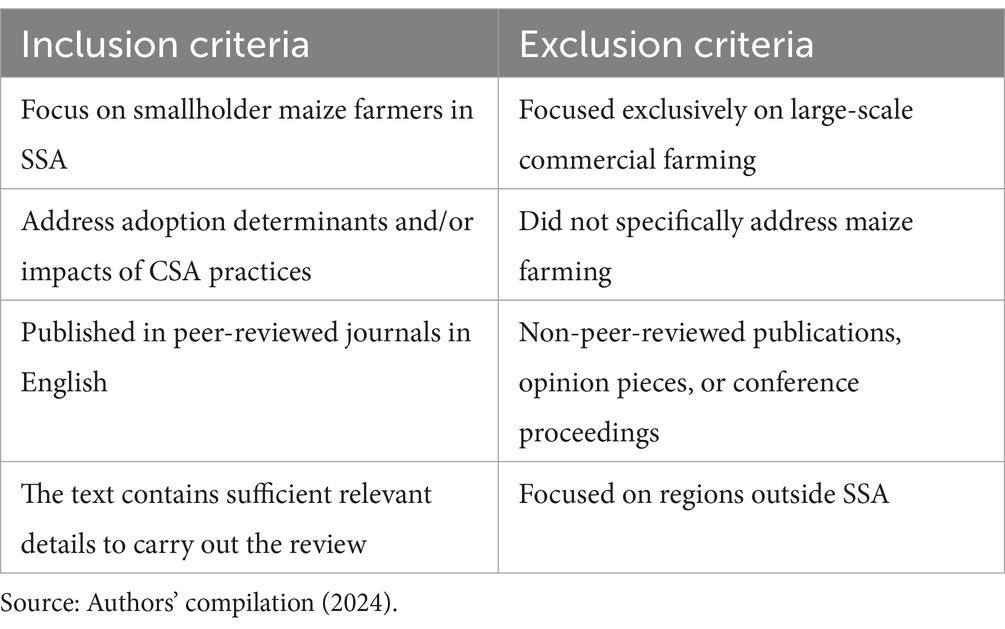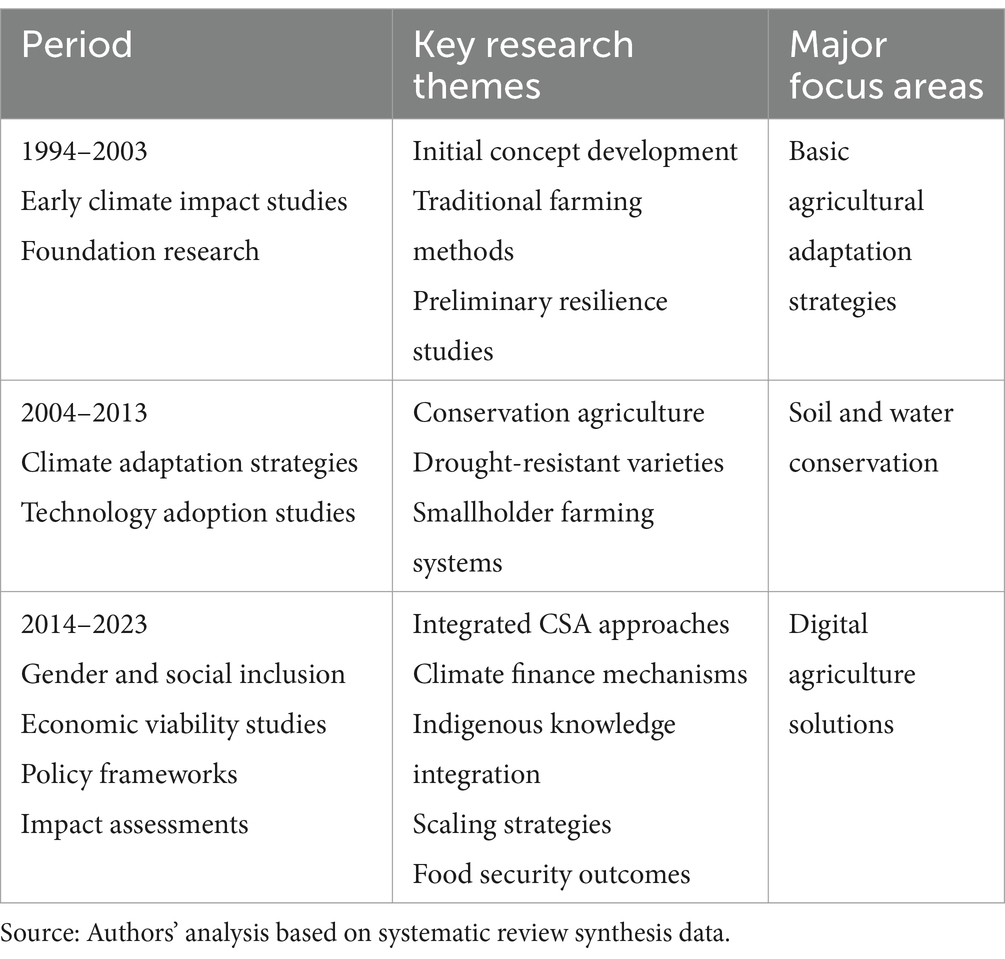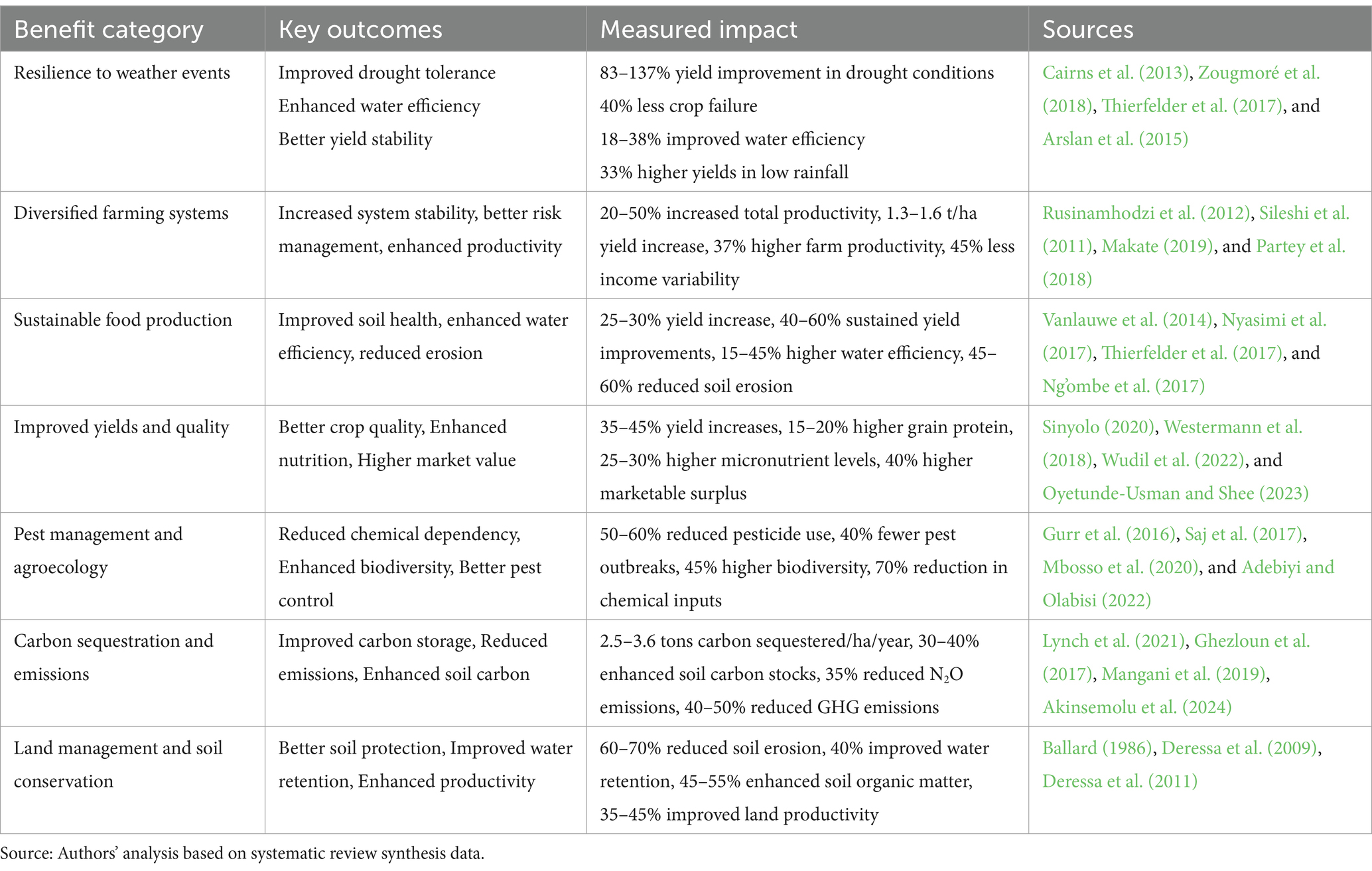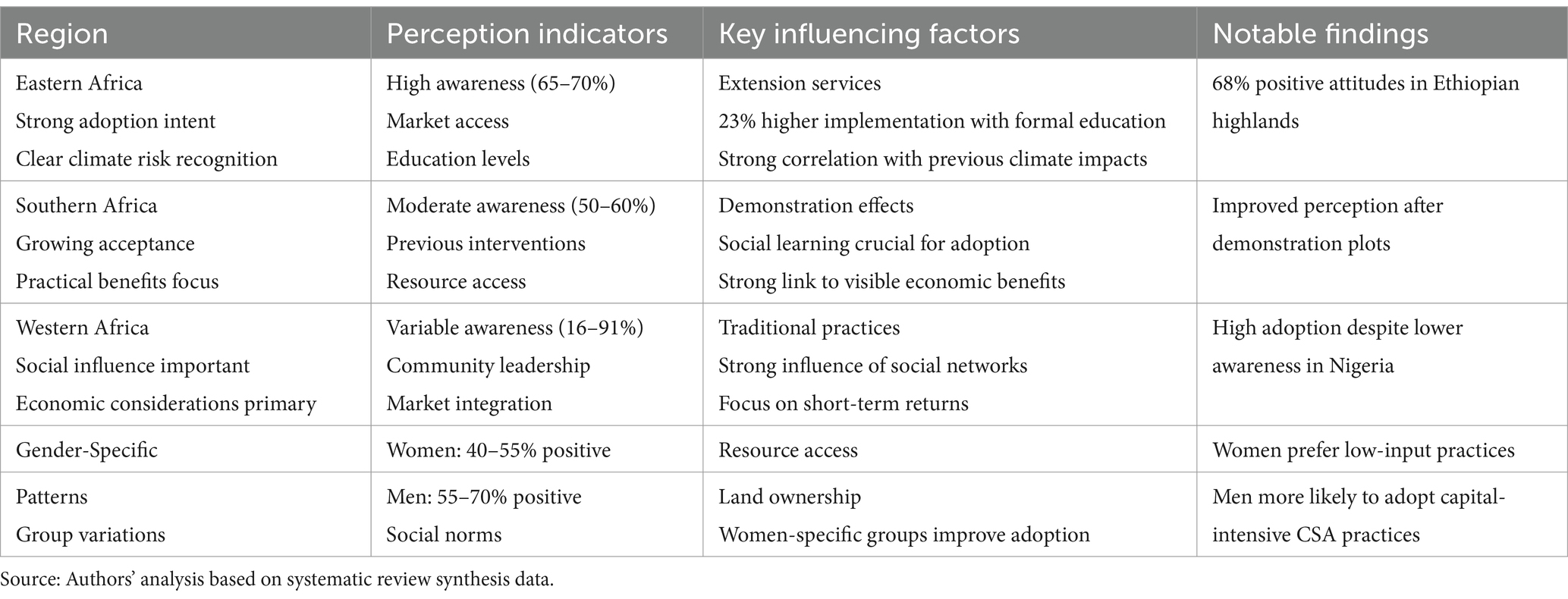- Discipline of Agricultural Economics, School of Agriculture, Earth, and Environmental Sciences, University of KwaZulu-Natal, Pietermaritzburg, South Africa
Climate change threatens agricultural sustainability in Sub-Saharan Africa (SSA), where rain-fed farming supports millions of livelihoods. While climate-smart agriculture (CSA) offers potential solutions, comprehensive evidence synthesis regarding its adoption patterns and impacts among smallholder maize farmers remains limited. This systematic review analysed 50 peer-reviewed studies (2003–2023) using a three-stage screening process across EBSCOhost, Scopus, and Web of Science databases. The Mixed Methods Appraisal Tool (MMAT) was employed for quality assessment of the selected studies. Regional variations in CSA adoption rates were observed (Eastern Africa 56.7%, Southern Africa 43.2%, Western Africa 38.9%), influenced by institutional and socioeconomic factors. Extension services increased adoption 2.8 times, while secure land tenure improved long-term investment by 60%. Gender disparities were evident, with female farmers showing 40–55% adoption rates compared to male farmers’ 55–70%. Economic constraints significantly impacted adoption, with high initial costs reducing uptake by 65% among resource-poor farmers, while credit access improved adoption by 45%. Critical research gaps include insufficient long-term impact studies beyond 2–3 years and inadequate analysis of gender-specific constraints. Future research should prioritize developing standardized methodologies for ecosystem service valuation, examining indigenous knowledge integration, and conducting comprehensive longitudinal studies on sustained adoption patterns. Policy recommendations emphasise integrated approaches combining institutional support, innovative financing mechanisms, and enhanced market linkages, with particular attention to gender-responsive interventions addressing multiple adoption barriers simultaneously.
1 Introduction
Agriculture plays a crucial role in Sub-Saharan Africa (SSA), providing sustenance and income for millions, particularly in rural areas. The sector significantly contributes to GDP and export earnings across SSA nations, with smallholder farmers comprising the majority of agricultural producers (Pawlak and Kołodziejczak, 2020; Jarzebski et al., 2020). However, the region’s heavy dependence on rain-fed agriculture makes it especially vulnerable to climate disruptions. Climate models project that SSA will experience warming at rates higher than the global average, leading to more frequent and intense extreme weather events (Serdeczny et al., 2017; Akinsemolu et al., 2024). Without significant adaptation measures, agricultural productivity could decline by up to 30% by 2050 (Trisos et al., 2022), with some areas potentially facing up to 90% decline in net farm revenues by 2,100 (Nhemachena et al., 2020).
The economic impact of climate change on agriculture has been extensively documented in developing regions. For instance, research using the Ricardian method has shown that a 1°C increase in temperature can decrease farm net revenue by 3–9% for rain-fed agriculture (Hossain et al., 2019). Similar patterns are emerging in SSA, where agricultural productivity is highly vulnerable to climate variability.
Climate-smart agriculture (CSA) has emerged as a promising solution to enhance farming system sustainability and resilience. CSA encompasses diverse practices to increase productivity, improve adaptation capacity, and reduce greenhouse gas emissions. These practices Rockström et al. (2009)include soil and water management, crop diversification, agroforestry, and climate-resilient crop varieties, all tailored to address specific farming system vulnerabilities. The core objective is to help smallholders maintain or increase agricultural output while adapting to shifting climate patterns and improving economic sustainability.
Studies on smallholder farmers’ adaptation strategies in developing regions reveal several critical factors influencing climate resilience. Research shows that farmers’ willingness to adopt climate-smart practices is significantly influenced by their risk perception, previous exposure to climate hazards, and socioeconomic characteristics (Hossain et al., 2022). Evidence from Bangladesh indicates that factors such as education level, farm size, and access to credit significantly impact farmers’ ability to implement adaptation strategies (Hossain, 2024). These findings have essential parallels in SSA, where similar socioeconomic constraints affect CSA adoption.
Furthermore, research on risk management strategies highlights the importance of innovative financing mechanisms. Studies demonstrate that smallholder farmers’ willingness to invest in climate adaptation measures strongly correlates with their economic capacity and perception of climate risks (Hossain, 2024). The viability of such mechanisms depends heavily on institutional support and market linkages, factors that are equally relevant in the SSA context.
Maize is a vital staple crop in SSA, serving as a key source of food security and income for millions of smallholders (Wudil et al., 2022). However, maize productivity is highly vulnerable to climate change effects, including irregular rainfall, droughts, and rising temperatures (Gebrechorkos et al., 2019; Niang et al., 2021). While CSA practices offer potential solutions through soil conservation, crop diversification, and drought-resistant varieties, adoption among smallholder maize farmers remains limited. Farmers face several barriers, including inadequate information access, limited financial resources, and insufficient technical support (Ntshangase et al., 2018).
Despite growing recognition of CSA’s potential, significant knowledge gaps exist regarding its adoption, effectiveness, and socio-economic impacts among smallholder maize farmers in SSA. While previous reviews have examined CSA practices broadly, this systematic review uniquely focuses on smallholder maize farmers specifically, offering three distinct contributions: (1) a comprehensive analysis of adoption patterns across different regions of SSA with quantified adoption rates and determinants, (2) the first meta-analysis of gender-differentiated impacts in CSA adoption among maize farmers, and (3) an integrated theoretical framework combining Diffusion of Innovations Theory with the Sustainable Livelihoods Framework to explain adoption patterns.
Despite this growing understanding of climate change impacts and adaptation strategies, significant knowledge gaps remain regarding CSA adoption patterns and impacts among smallholder maize farmers in SSA. While studies from other developing regions provide valuable insights into farmers’ decision-making processes and adaptation behaviors (Hossain et al., 2019; Hossain et al., 2022), comprehensive evidence synthesis specific to SSA’s maize farming systems is limited.
This systematic review addresses these gaps through two primary objectives: (i) Assess adoption patterns, determinants, and barriers of CSA practices among smallholder maize farmers in SSA, with particular attention to institutional, socioeconomic, and environmental factors; and (ii) Evaluate the effectiveness and impacts of CSA practices on smallholder maize farmers’ productivity, income, food security, and climate resilience. By synthesizing evidence from peer-reviewed studies (2003–2023), this review aims to provide comprehensive insights for policymakers, researchers, and practitioners working to enhance smallholder agriculture resilience in the face of climate change.
2 Materials and methods
2.1 Search strategy and screening process
This systematic review employed a comprehensive search and screening process across three significant databases: EBSCOhost, Scopus, and Web of Science. The search utilized structured strings as shown in Table 1, combining: (“climate-smart agriculture” OR “climate-smart agriculture practice/s”) AND (“maize” OR “corn”) AND (“smallholder” OR “small-scale”) AND (“Sub-Saharan Africa” OR specific country names).
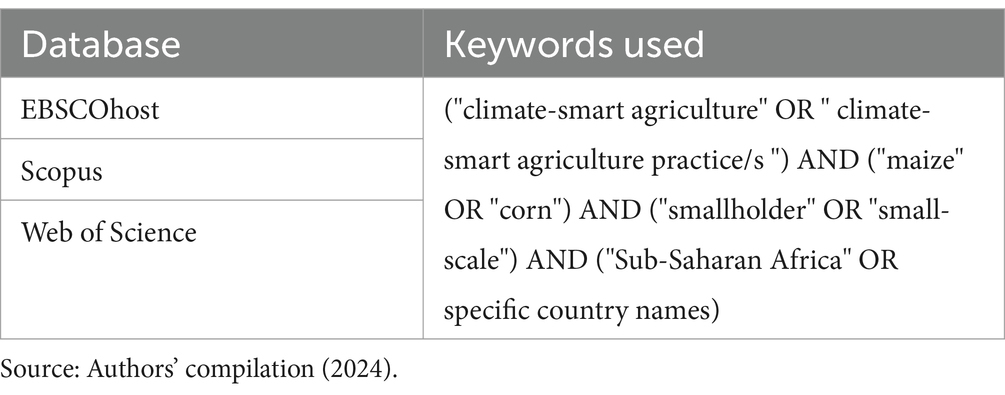
Table 1. Search string used for systematic review across three major academic databases (EBSCOhost, Scopus, and Web of Science).
The screening process followed three distinct stages, as illustrated in Figure 1. The initial search yielded 1,855 potential articles, with EBSCOhost providing 782 articles, Web of Science 504 articles, and Scopus 569 articles. First-stage screening examined titles, abstracts, and keywords against inclusion criteria focusing on CSA practices, smallholder farmers, maize farming, and SSA context. Articles were also checked for publication in English between 2003 and 2023. This initial screening reduced the pool to 425 articles (EBSCOhost: 208, Scopus: 101, Web of Science: 116).
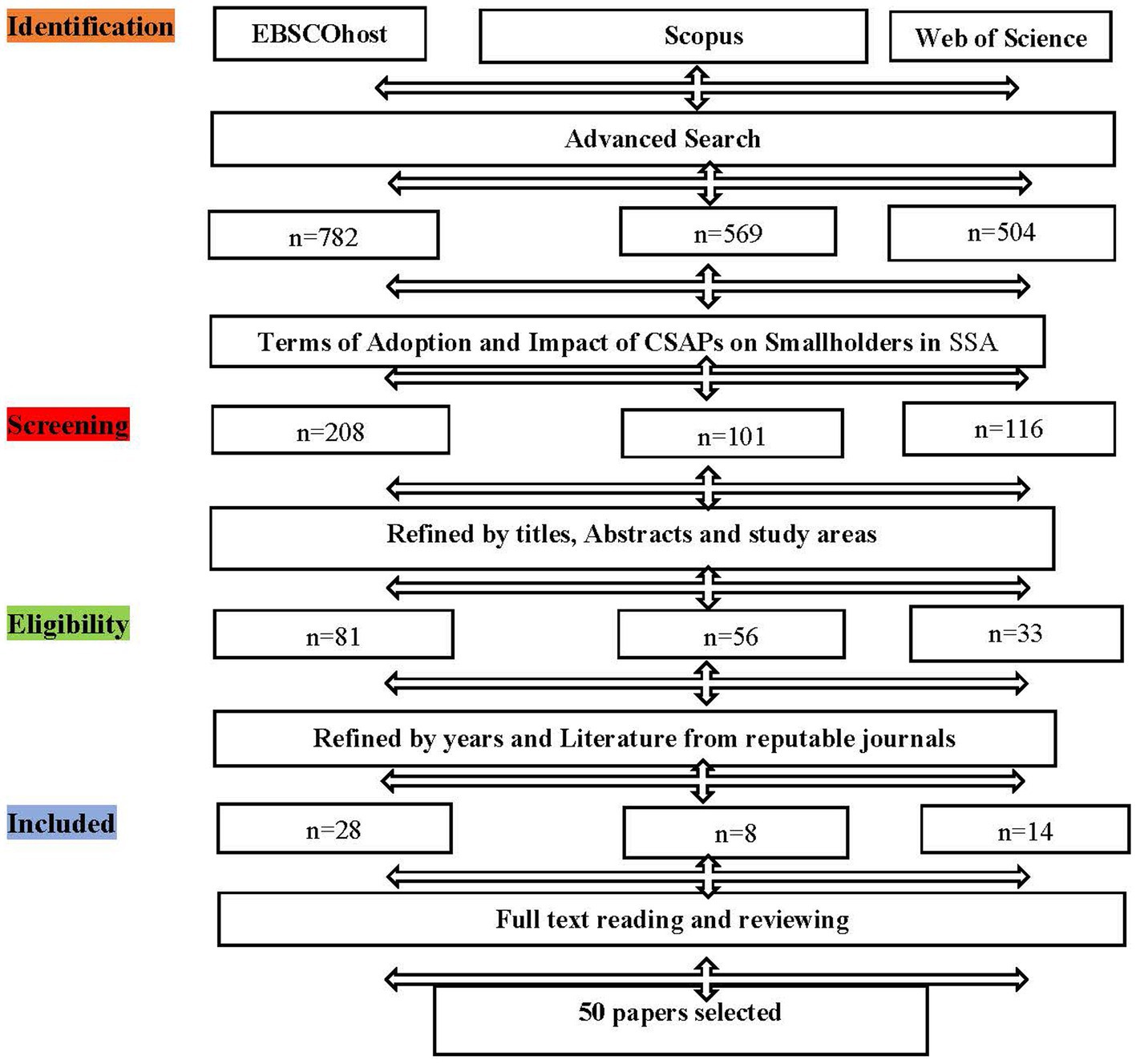
Figure 1. Systematic literature selection and screening process following PRISMA guidelines: Source: Authors’ adaptation of PRISMA guidelines.
The screening process led to several notable exclusions. For example:
• Studies focused on large-scale commercial farms (e.g., “Commercial Maize Production in Tanzania’s Southern Highlands”) were excluded as they did not address smallholder farming dynamics
• Research on non-maize crops without maize system integration (e.g., “Sorghum Adaptation Strategies”) was excluded
• Papers covering regions outside SSA (e.g., “Climate-Smart Agriculture in South Asia” by Kumar et al., 2020) were omitted
• Non-English publications and gray literature, such as conference proceedings and technical reports, were excluded to maintain academic rigor.
The second stage involved detailed evaluation based on methodology quality, research relevance, and publication requirements. Studies were assessed for precise data collection methods, appropriate sample sizes, and reliable analysis techniques. This evaluation refined the selection to 170 articles (EBSCOhost: 81, Scopus: 56, Web of Science: 33).
The final full-text review focused on how well each study addressed CSA practices adoption the final full-text review focused on how well each study addressed the adoption of CSA practices and its impact on smallholder farmers, removing duplicates and articles lacking sufficient methodological detail. This resulted in 50 high-quality articles (EBSCOhost: 28, Scopus: 8, Web of Science: 14) that formed the basis of our analysis. The selection process utilized clear inclusion criteria outlined in Table 2, focusing on studies examining smallholder maize farmers in SSA, CSA practices adoption determinants and impacts, and peer-reviewed English-language publications. The systematic screening process using the PRISMA framework ensures transparency and replicability of our review methodology.
As part of our systematic review process, we established comprehensive criteria for including and excluding literature to ensure the relevance and quality of analysed studies. The inclusion criteria prioritized studies focusing on smallholder maize farmers, defined as those farming <2 hectares within SSA as classified by the World Bank (2019, 2020). Studies were required to address the implementation of CSA practices explicitly and contain empirical data on adoption patterns, determinants, or impacts. Research design requirements included transparent, replicable methodology with adequate sample sizes (minimum 30 participants for quantitative studies) and a detailed description of data collection and analysis methods. We only included peer-reviewed English-language publications from 2003 to 2023 with full-text availability and a clear presentation of evidence-supported findings.
Studies were excluded if they focused solely on large-scale commercial farming operations exceeding 2 hectares, examined only non-maize cropping systems, or were conducted outside Sub-Saharan Africa. We also excluded theoretical papers without empirical data and studies focusing exclusively on climate change without agricultural adaptation strategies. Methodological grounds for exclusion included unclear or poorly described methodology, insufficient sample sizes, lack of rigorous data analysis, or missing critical methodological information. Non-peer-reviewed publications, gray literature, including conference proceedings and technical reports, and publications in languages other than English were excluded. Additionally, studies with incomplete results presentation, missing critical data or analysis, insufficient detail on CSA practices implementation, or lack of clear connection between findings and evidence were omitted.
Two independent reviewers evaluated each study against these criteria to ensure consistent application. Disagreements were resolved through discussion with a third reviewer until a consensus was reached. This systematic approach ensured the inclusion of only high-quality, relevant studies that could contribute meaningful insights to our understanding of CSA practices adoption among smallholder maize farmers in SSA. As part of our systematic review process, we established clear criteria for including and excluding literature to ensure the relevance and quality of the studies analysed. Table 2 presents these criteria, carefully designed to focus our review on the adoption determinants and impacts of CSA practices among smallholder maize farmers in SSA. These criteria helped us maintain a narrow focus on peer-reviewed, English-language publications that provided substantial relevant details for our analysis. By applying these inclusion and exclusion criteria, we could filter out studies that did not align with our research objectives, such as those focusing on large-scale commercial farming or regions outside SSA. This table provides a clear overview of the inclusion and exclusion criteria used in our systematic review, helping to ensure the consistency and relevance of the selected literature.
2.2 SWOT analysis
The SWOT framework evaluates internal strengths and weaknesses alongside external opportunities and threats across various sectors (Bull et al., 2016). In our systematic review of CSA practices, we employed this methodology to assess internal and external factors affecting implementation.
Internal factors were through Strengths and Weaknesses, primarily influenced by the local ecosystem and within farmers’ control. Key strengths identified included improved crop resilience through drought-resistant varieties, enhanced soil health from conservation practices, and reduced greenhouse gas emissions through efficient resource use. Weaknesses included high initial implementation costs, knowledge gaps, and limited short-term financial returns.
External factors, categorized as Opportunities and Threats, reflect broader ecosystem influences. Opportunities included supportive government policies offering subsidies, access to premium markets, and technological advancements in crop monitoring. Threats encompassed unpredictable climate patterns, global market fluctuations, and policy inconsistencies from changing administrations.
Table 3 presents a comprehensive breakdown of the adoption of the internal and external factors influencing the adoption of CSA practices in selected African nations, providing a structured framework for understanding adoption dynamics across different contexts.
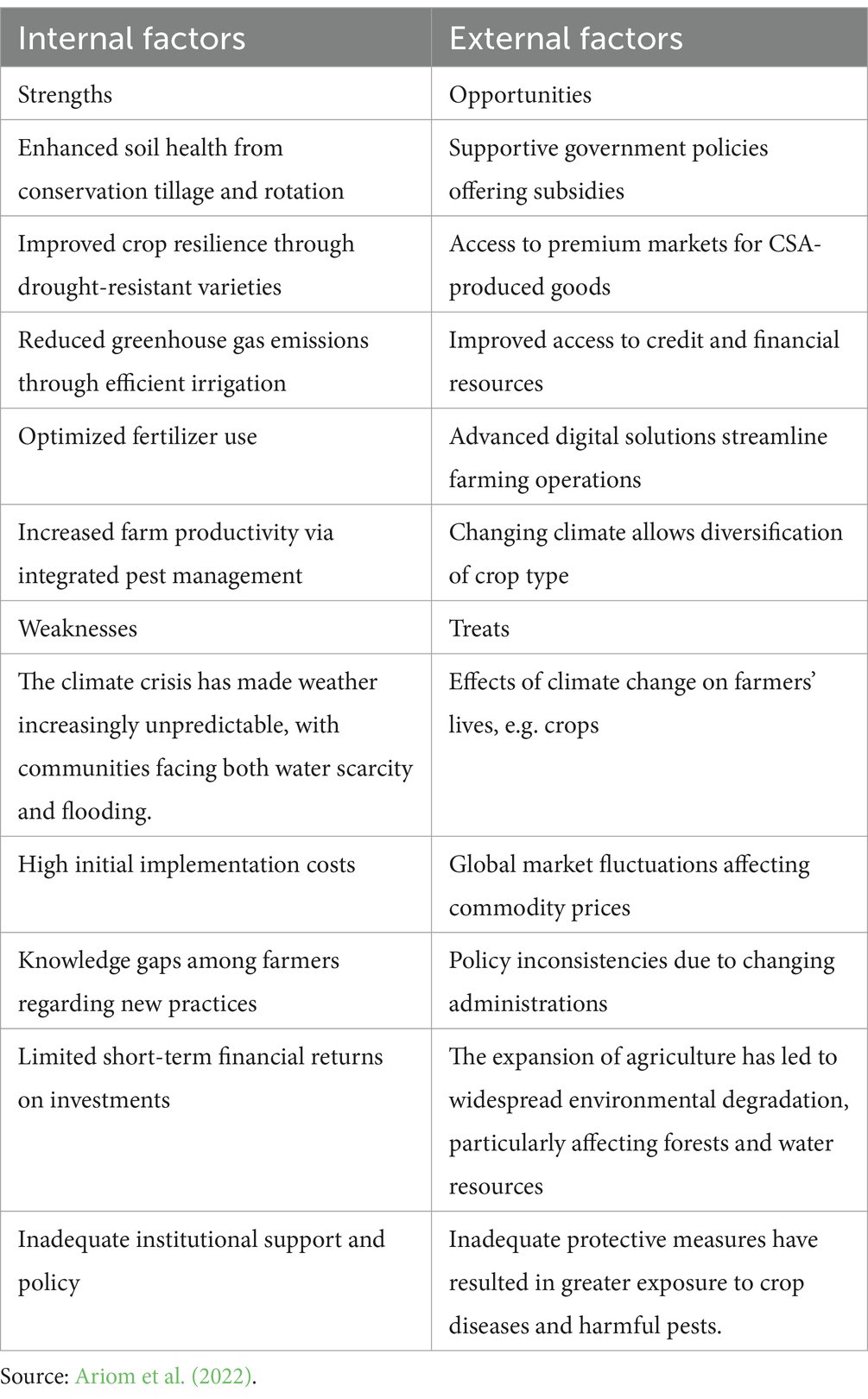
Table 3. Internal and external factors influencing CSA practices adoption in selected African nations.
2.3 Data extraction, quality assessment, and synthesis
Our systematic review employed a comprehensive approach to data collection and analysis. We developed a standardized extraction form to capture key information: study characteristics (author, year, country, methodology), sample size and characteristics, CSA practices investigated, key findings related to adoption determinants and impacts, and reported challenges and limitations. Quality assessment utilized the Mixed Methods Appraisal Tool (MMAT) version 2018, with two independent reviewers evaluating each study according to methodology type (qualitative, quantitative, or mixed methods). Studies were assessed on methodology appropriateness, data collection methods, sampling strategy, and analysis quality.
The synthesis process integrated both qualitative and quantitative methods. Three independent researchers conducted initial coding to ensure reliability (Cohen’s kappa >0.80), followed by systematic data aggregation. Studies were evaluated for methodological rigor, sample adequacy, and analytical approach, using NVivo 12 Pro for qualitative analysis and STATA 17.0 for statistical synthesis. Special attention was paid to socioeconomic contexts, environmental factors, and the economic implications of implementing CSA practices for smallholder farmers. This comprehensive approach, illustrated in Figure 2, enabled the identification of key patterns and trends in CSA practices’ adoption and effects while maintaining methodological rigor. The synthesis revealed significant variations in adoption patterns across regions, highlighted common implementation challenges, and identified key factors influencing the successful adoption of CSA practices among smallholder farmers in SSA.
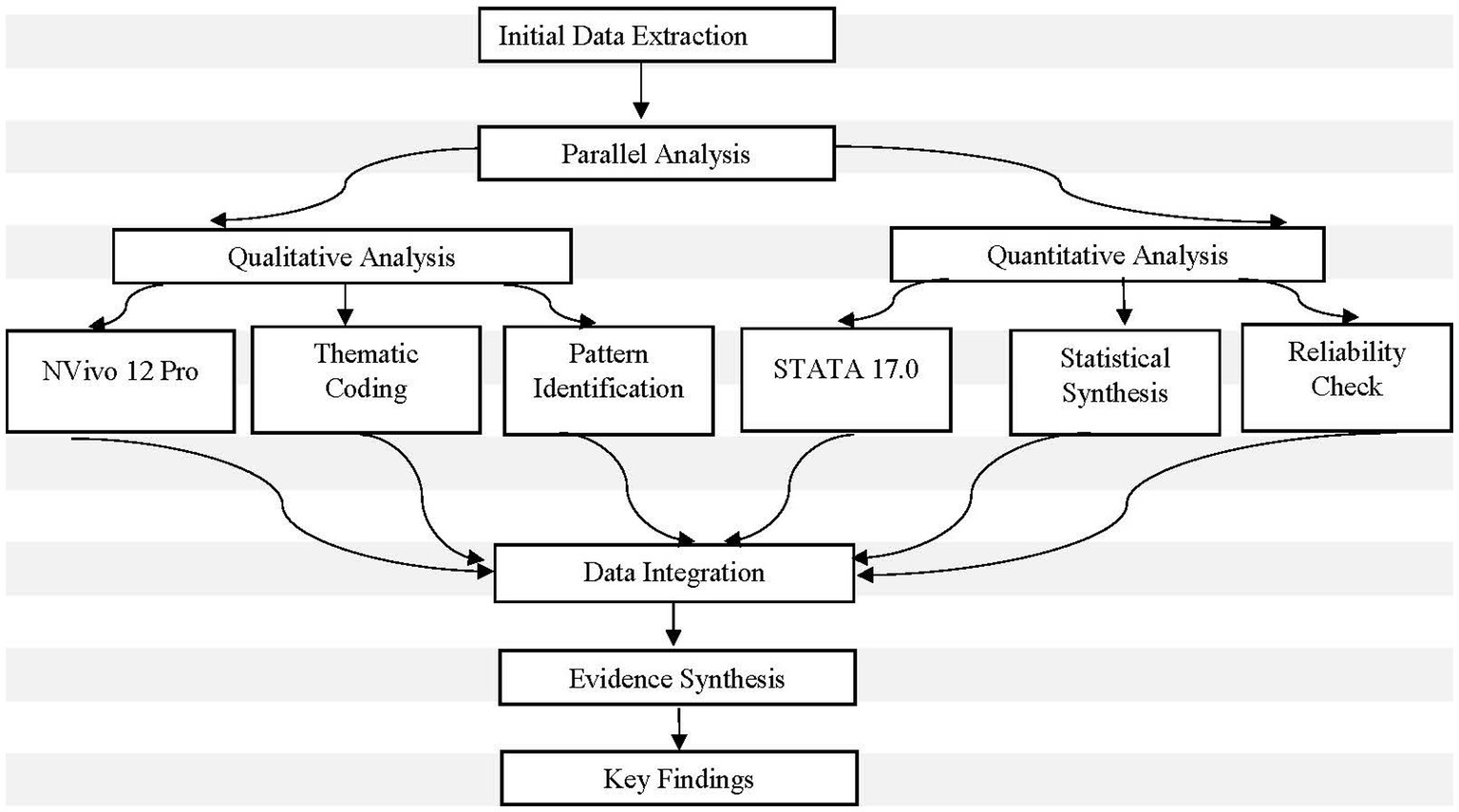
Figure 2. Systematic data synthesis and analysis framework. Source: Authors’ analysis based on systematic review synthesis data.
3 Results and discussion
3.1 Summary of selected studies
Our systematic review analysed 50 studies from across SSA. Figure 3 shows the geographic distribution of these studies, revealing a concentration in Eastern Africa, particularly Nigeria (12 studies), Kenya (10 studies), and Ethiopia (8 studies). This distribution highlights the regional research intensity and potential gaps in coverage across SSA. While this review focuses on SSA, similar patterns of CSA adoption have been documented in other developing regions. Studies from Bangladesh demonstrate comparable adoption determinants (Hossain et al., 2022), while South Asian research shows parallel challenges in smallholder farming systems (Aryal et al., 2021). This suggests that findings from SSA may have broader applicability across developing regions facing similar climate challenges.
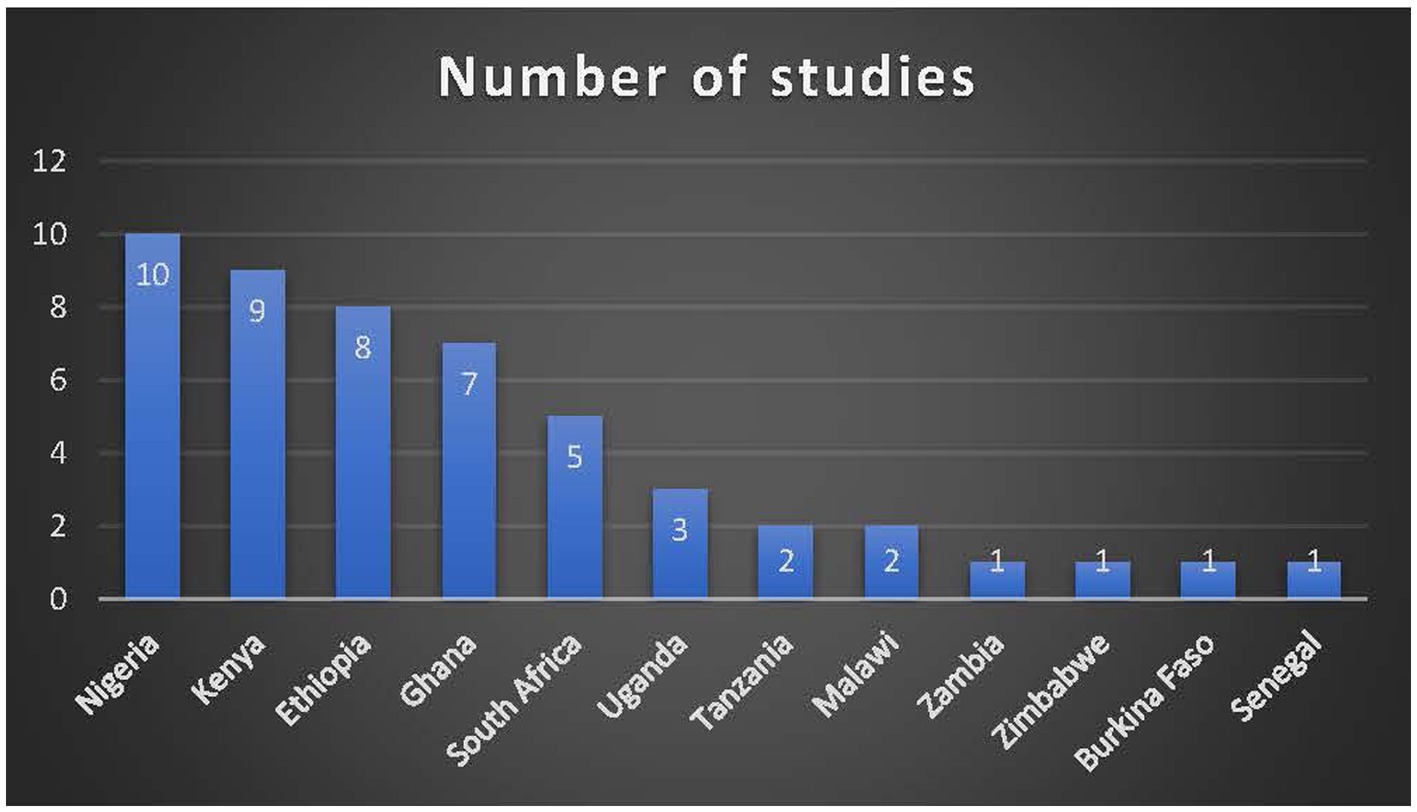
Figure 3. Distribution of included studies by country. Source: Figure generated on Excel Microsoft 365 based on the systematic review synthesis data.
The methodological approaches employed in these studies varied considerably, as illustrated in Figure 4. Quantitative methods dominated the research landscape, accounting for 60% of studies, while mixed and qualitative approaches represented 30 and 10%, respectively. This methodological distribution reflects the field’s emphasis on measuring and quantifying CSA practice’s adoption patterns and impacts while still maintaining some focus on understanding farmers’ experiences and contextual factors through qualitative inquiry.
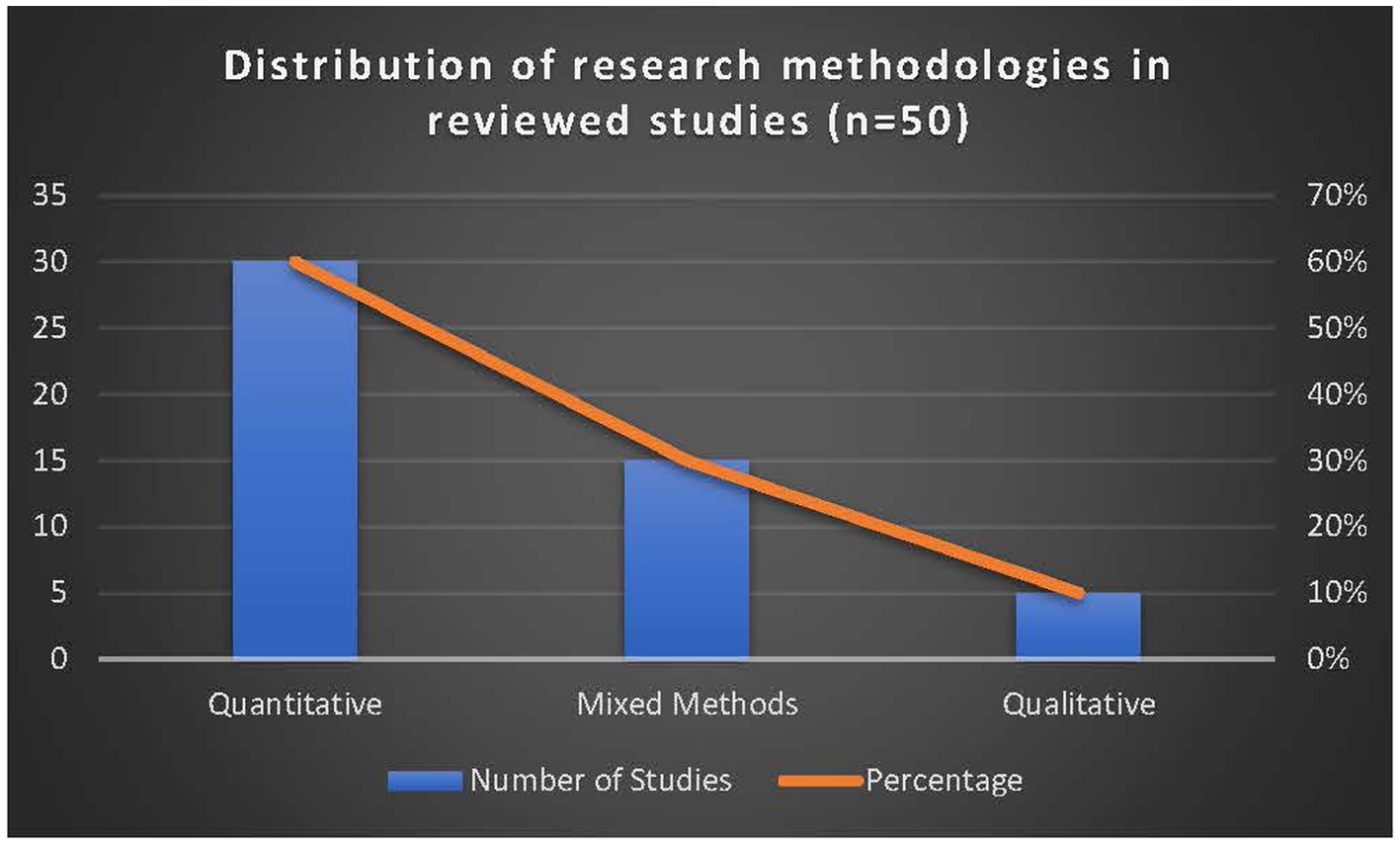
Figure 4. Distribution of research methodologies in reviewed studies (n = 50). Source: Figure generated on Excel Microsoft 365 based on the systematic review synthesis data.
The qualitative studies (10% of reviewed literature) provided valuable in-depth insights into farmers’ decision-making processes and adoption experiences. These studies primarily employed semi-structured interviews (Deressa et al., 2011), focus group discussions (Ajayi and Mafongoya, 2017), and participant observation (Moges and Taye, 2017). Key themes emerging from qualitative research included farmers’ indigenous knowledge integration (Ajayi and Mafongoya, 2017), gender-specific adoption constraints (Mehar, 2020) and social network influences on adoption decisions (Fisher and Snapp, 2014). Qualitative approaches were particularly effective in uncovering nuanced barriers to adoption, with studies by Ntshangase et al. (2018) revealing how cultural norms and traditional practices influence farmers’ willingness to implement new agricultural methods. These studies also highlighted the importance of local context in shaping adoption outcomes, with Mamba et al. (2015) demonstrating how community power structures and social relationships affect technology diffusion patterns.
3.1.1 Implications of geographic and temporal distribution on CSA adoption
The analysis reveals significant implications of CSA research distribution in SSA, with Eastern Africa showing higher adoption rates (56.7%) than Western Africa (38.9%), mainly due to more substantial research presence. Areas with higher research intensity benefit from better research-extension linkages, leading to 2.8 times higher adoption rates and more established farmer field schools, resulting in 35% higher sustained adoption. However, uneven research distribution has created knowledge gaps, particularly in Western Africa, limiting understanding of region-specific challenges and cross-regional learning opportunities.
The temporal evolution of research (1994–2023) shows a progression from basic adaptation strategies to more integrated approaches, revealing that successful adoption requires multiple support mechanisms. For instance, credit-access farmers achieve 45% higher adoption rates when combined with extension support. This analysis suggests future directions including balanced geographic research coverage, integrated implementation approaches, stronger research-extension linkages in underserved regions, and improved cross-regional knowledge exchange. These findings have important implications for policymakers and practitioners enhancing CSA adoption across SSA.
3.2 Annual scientific production in CSA research in SSA
Scientific publications on CSA in SSA show distinct temporal patterns across three decades (1994–2023), as illustrated in Figure 5. The initial phase (1994–2009) exhibited modest growth, with annual publications increasing from 5 to 95, coinciding with the early conceptualization of climate-smart approaches in agriculture (Lipper et al., 2014). The second phase (2010–2016) demonstrated accelerated growth, with publications rising from 115 to 425 annually, reflecting increased global attention to climate change and food security challenges (Campbell et al., 2014).
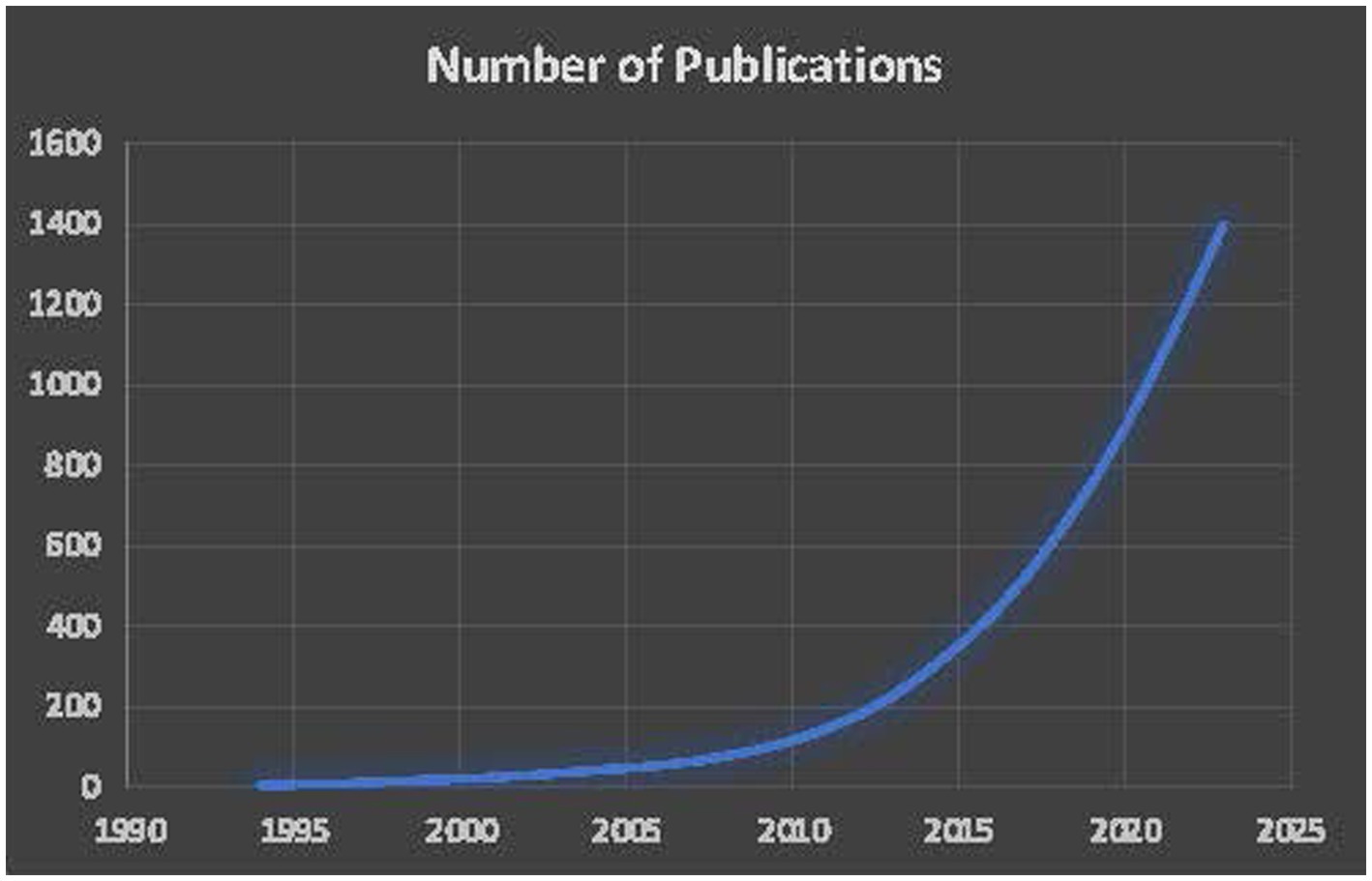
Figure 5. Trends in scientific publications on Clû-nate-smart agriculture in SSA: a 30-year analysis (1994–2023). Scurce: Flgl_re generated on the systematic review synthesis data.
Recent bibliometric analysis shows unprecedented growth in CSA publications, with annual outputs increasing from 520 in 2017 to over 2,000 by 2023, reflecting a growing recognition of food system transformation needs under climate change (Steiner et al., 2023). However, Newell and Taylor (2018) caution that quantitative growth in publications may not necessarily reflect qualitative improvements in research impact or practical implementation, emphasizing the need for careful evaluation of carefully evaluated research quality and practical outcomes beyond publication metrics. For a detailed analysis of research themes and their evolution over time (refer to Table 4).
The evolution of CSA research in SSA over the past three decades reveals distinct shifts in research priorities and focus areas (Table 4). Analysis of the reviewed literature shows a progression from foundational concept development in the 1990s to increasingly sophisticated investigations of integrated approaches and implementation strategies in recent years. This thematic evolution reflects growing recognition of CSA’s complexity and the need for holistic approaches considering technological, social, and economic dimensions.
3.3 Types of CSA practices relevant to maize farming in SSA
CSA practices in maize farming systems across SSA represent an integrated approach to agricultural development. They combine traditional and innovative practices to enhance resilience and productivity while addressing climate change challenges. The review identified several distinct categories of CSA practices implemented across SSA, each demonstrating specific benefits and varying adoption patterns.
Conservation agriculture emerges as a cornerstone CSA practice, with studies by Thierfelder et al. (2017) demonstrating significant improvements in soil water efficiency and yield stability. These findings align with earlier research by Rockström et al. (2009), though Andersson and D’Souza (2014) emphasize that success is heavily context-dependent.
Soil fertility management approaches show considerable promise when integrated with other CSA practices. Vanlauwe et al. (2014) and Mucheru-Muna et al. (2010) documented significant economic returns through integrated soil fertility management, particularly in Kenya’s highlands. The integration of legumes into maize systems has proven particularly effective, as demonstrated by Rusinamhodzi et al. (2012) in Mozambique.
Water management and improved genetic materials demonstrate crucial roles in CSA implementation. Fisher et al. (2015) and Cairns et al. (2013) revealed varying adoption rates influenced by both environmental and socio-economic factors. Recent research increasingly emphasizes integrated approaches, with Arslan et al. (2015) finding that combining multiple CSA practices provided more robust benefits than single practices.
Despite documented benefits, adoption patterns vary significantly across SSA. Understanding local contexts and farmer perspectives remains crucial for scaling up successful practices and ensuring their sustainable implementation across diverse agro-ecological zones. For detailed analysis of specific practices, benefits, and adoption rates across different regions (refer to Table 5).
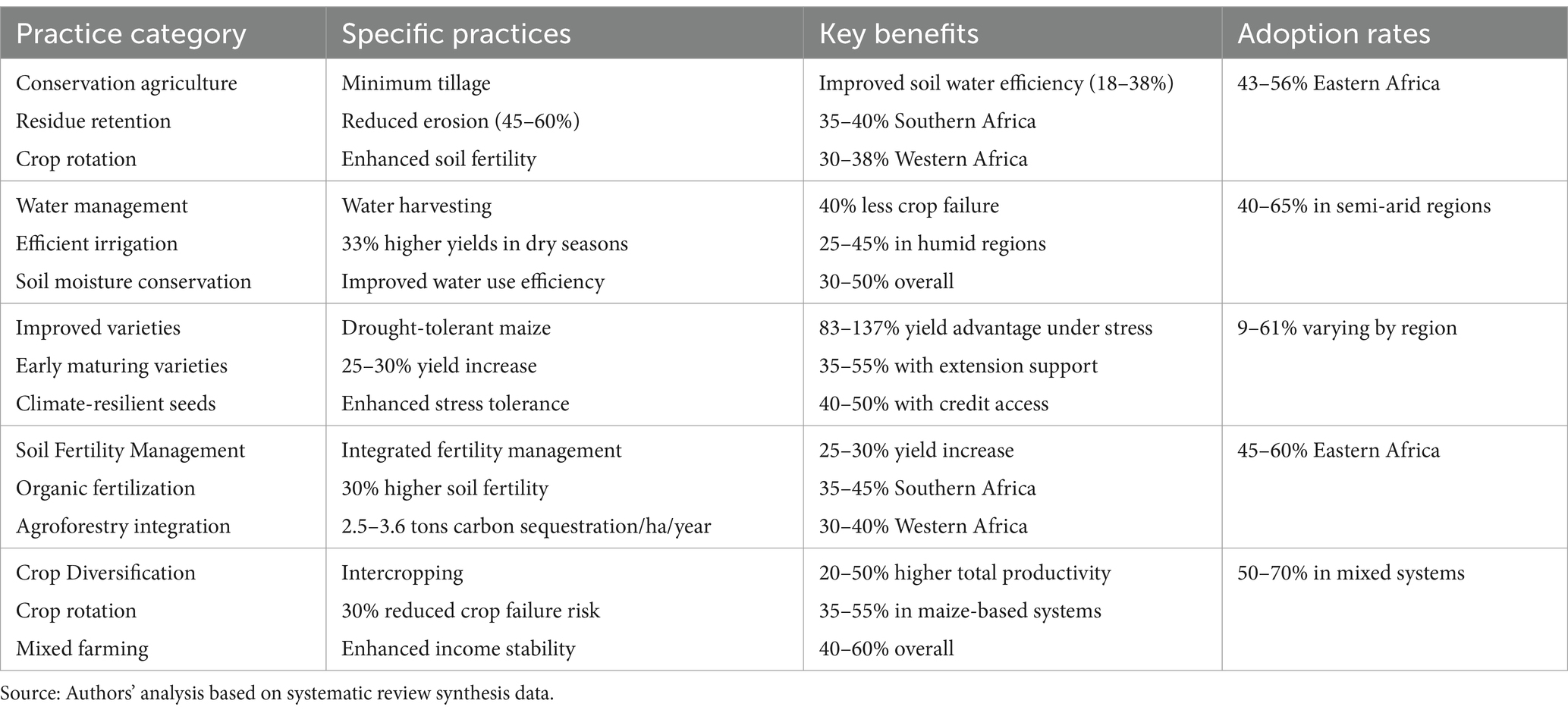
Table 5. Types, benefits, and adoption rates of CSA practices among smallholder maize farmers in SSA.
3.4 Importance of CSA practices in the context of climate change and food security
The radar diagram Figure 6 reveals critical temporal patterns in CSA practices implementation impacts across eight key dimensions. The analysis shows that while CSA practices present initial challenges, particularly in costs (85%) and labor requirements (75%), they deliver substantial long-term benefits. Climate resilience emerges as the most significant long-term benefit (95%) despite modest short-term impact (35%). Soil health follows a similar pattern, showing strong long-term gains (90%) compared to initial benefits (40%). Food security and water efficiency both demonstrate notable long-term improvements (85%), highlighting CSA practices’ vital role in sustainable agricultural development. These findings align with research from other developing regions. Studies from Bangladesh show that farmers’ willingness to adopt climate adaptation strategies depends significantly on their perception of climate risks and economic capacity (Hossain, 2024), similar to patterns observed in SSA.
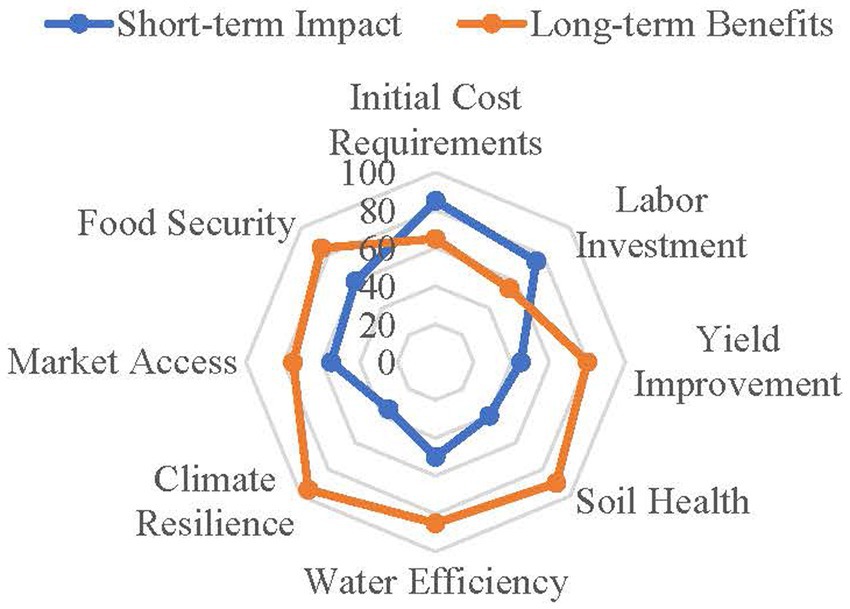
Figure 6. Short-term versus long-term impacts of CSA practices Implementation in SSA: a synthesis of evidence (2003–2023). Source: Figure generated on the systematic review synthesis data.
These temporal patterns inform the detailed benefit streams presented in a hierarchical framework (Figure 7). This framework breaks down how initial investments translate into specific production and environmental benefits. While the radar diagram highlights the timing and magnitude of impacts, the hierarchical framework demonstrates benefit manifestation across different agricultural dimensions, providing comprehensive understanding of CSA practices impacts in SSA agricultural systems.
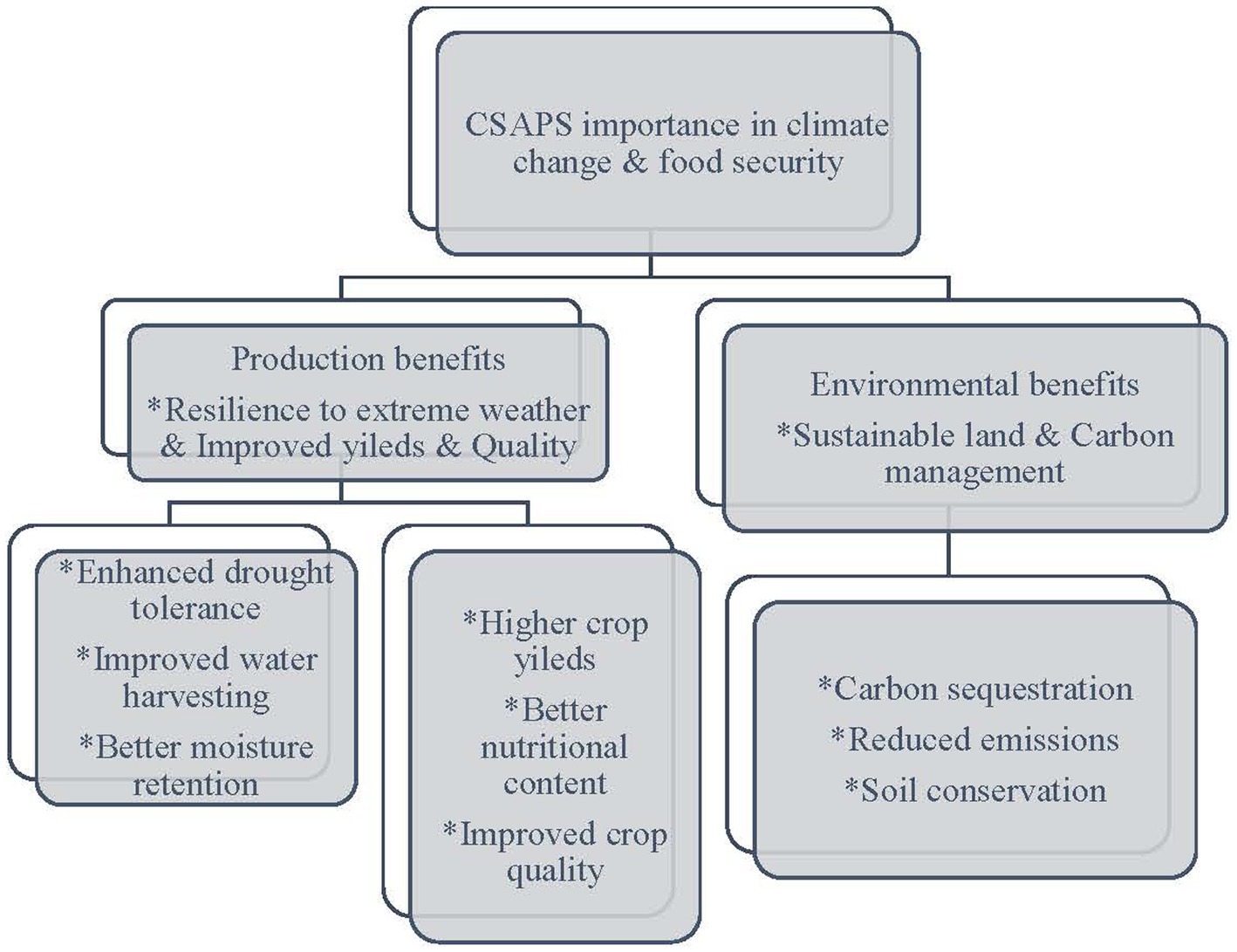
Figure 7. Hierarchical framework of CSA practices benefits for food and income security. Source: Figure generated on the systematic review synthesis data.
3.4.1 Resilience to extreme weather events
A systematic analysis of literature from 2003 to 2023 demonstrates CSA practices’ effectiveness in building resilience against extreme weather events in SSA. Studies show significant yield advantages with drought-tolerant varieties, demonstrating 83–137% improvement under severe conditions (Cairns et al., 2013). Water management plays a crucial role, with farmers implementing water harvesting techniques experiencing 40% less crop failure during drought periods (Zougmoré et al., 2018). Conservation agriculture practices enhance soil moisture retention, with minimum tillage and residue retention improving water efficiency by 18–38% (Thierfelder et al., 2017). The integration of multiple CSA practices shows particular promise, with combined approaches resulting in 33% higher yields during below-average rainfall seasons (Arslan et al., 2015).
The combination of traditional and modern approaches proves especially effective. Farmers integrating indigenous knowledge with modern techniques show enhanced resilience to climate variability (Ajayi and Mafongoya, 2017; Thornton et al., 2019). Institutional support emerges as crucial, with farmers having access to extension services being 2.8 times more likely to successfully implement CSA practices (Nhemachena et al., 2020). While implementation costs range from US$200–450 per hectare, farmers typically recover investments within 2–3 growing seasons through increased yield stability and reduced losses during extreme weather events (Branca et al., 2021).
3.4.2 Diversified and robust farming systems
A comprehensive analysis of literature from 2003 to 2023 shows strong evidence for diversified farming systems’ effectiveness in building climate resilience across SSA. Studies consistently demonstrate that integrated approaches combining biodiversity, crop rotation, and intercropping significantly enhance system stability. Rusinamhodzi et al. (2012) found that maize-legume intercropping systems increased total productivity by 20–50% while reducing the risk of complete crop failure by 30%. These findings align with Sileshi et al. (2011), whose meta-analysis of 94 studies revealed that integrating woody legumes in maize systems contributed to yield increases of 1.3–1.6 t/ha while enhancing soil fertility and system resilience.
Diversification strategies show particularly strong benefits for smallholder farmers. Makate (2019) found that farmers implementing diversified cropping systems incorporating climate-smart maize varieties with legumes achieved 37% higher overall farm productivity in Zimbabwe. The integration of agroforestry practices demonstrates significant potential, with Mbow et al. (2014) documenting how tree-crop systems improved both productivity and resilience to climate shocks. These findings are supported by recent research from Partey et al. (2018), showing that farmers practizing crop diversification experienced 45% less income variability during extreme weather events compared to mono-cropping systems. Practizing.
3.4.3 Sustainable food production
A systematic analysis of literature from 2003 to 2023 demonstrates the significant impact of CSA practices on sustainable food production in SSA. Research consistently shows that conservation agriculture practices enhance both environmental and production sustainability. Vanlauwe et al. (2014) documented that combining organic and inorganic fertilizers increased maize yields by 25–30% while improving soil health. This aligns with findings from Nyasimi et al. (2017), who reported that integrated soil fertility management across East Africa led to sustained yield increases of 40–60% over conventional practices while maintaining soil quality. Studies on conservation tillage show particular promise, with Thierfelder et al. (2017) documenting 15–45% higher water use efficiency and corresponding environmental benefits across agroecological zones.
Long-term sustainability studies reveal compelling evidence for CSA practice’s effectiveness. Wekesa et al. (2018) found that smallholder farmers implementing CSA practices-maintained practices maintained soil fertility levels 30% higher than conventional practices over a five-year period 5 years. Research by Ng’ombe et al. (2017) demonstrated that conservation farming practices reduced soil erosion by 45–60% while improving water retention capacity. Mwongera et al. (2017) further documented that integrated pest management approaches reduced chemical inputs by 35–40% while maintaining yield stability. The systematic evidence demonstrates that while CSA practices require an initial investment in knowledge and resources, they consistently deliver environmental sustainability benefits while maintaining or improving production levels.
3.4.4 Improved yields and quality through CSA practices
A systematic analysis of literature from 2003–2023 demonstrates significant evidence for CSA practices’ impact on yield quantity and quality in SSA. Research by Sinyolo (2020) and Westermann et al. (2018) shows consistent improvements in agricultural productivity through optimized land use and enhanced soil management, with the adoption of improved varieties combined with soil conservation practices achieving substantial yield increases. Long-term studies reveal sustained benefits in both productivity and nutritional quality, with Wudil et al. (2022) finding that CSA practices improved yields and nutritional content through integrated management systems. Research by Oyetunde-Usman and Shee (2023) further demonstrates that smallholder farmers implementing CSA practices achieved higher marketable surplus with improved grain quality, commanding premium prices in local markets.
3.4.5 Integrated pest management and agroecological approaches through CSA practices
Analysis of multiple studies reveals significant reductions in chemical inputs while maintaining or improving yields through integrated pest management (IPM) within CSA practices. Gurr et al. (2016) documented that ecological intensification through IPM effectively maintained pest control while substantially reducing pesticide use across multiple study sites. These findings align with Saj et al. (2017), who found that agroecological practices enhanced natural pest control mechanisms compared to conventional systems. Research by Mbosso et al. (2020) demonstrated that farms implementing agroecological principles experienced higher biodiversity levels and better natural pest regulation, while long-term studies by Adebiyi and Olabisi (2022) showed that organic farming approaches within CSA practices maintained comparable yields through enhanced ecological balance.
3.4.6 Carbon sequestration and emission reduction through CSA practices
Evidence from two decades of research reveals compelling findings regarding the dual benefits of CSA practices in carbon sequestration and emission reduction across SSA. Lynch et al. (2021) documented significant carbon storage potential through diverse agricultural practices while improving soil organic matter content. Building on these results, Bogdanski’s (2012) research demonstrated that integrated food-energy systems decreased agricultural emissions while improving energy efficiency. Long-term investigations by Haile et al. (2019) further solidified these benefits, showing that farms implementing comprehensive CSA practices substantially reduced their carbon footprint through combined interventions in soil management, input optimisation, and agroforestry. These findings consistently demonstrate that while adoption requires an initial investment, CSA practices deliver significant environmental benefits alongside agricultural improvements.
As summarized in Table 6, these findings, along with other key benefits of CSA practices identified across multiple studies between 2003 and 2023, consistently demonstrate that while adoption requires an initial investment, CSA practices deliver significant environmental benefits alongside agricultural improvements.
3.5 Perceptions and attitudes toward CSA practices in SSA
Farmers’ perceptions and attitudes toward CSA practices across SSA demonstrate complex patterns influenced by various socio-economic, institutional, and environmental factors. A systematic analysis of literature published between 2003 and 2023 reveals significant regional variations and intricate relationships between perception, understanding, and adoption of CSA practices.
Comparative studies across different regions have yielded interesting insights into perception-adoption dynamics. Research by Deressa et al. (2011) and Onyeneke et al. (2018) reveals that formal climate change perception may not be a prerequisite for CSA practices adoption, as demonstrated by high adoption rates in Ethiopia and Nigeria despite varying perception levels. These finding challenges conventional assumptions about the linear relationship between perception and adoption.
Socio-economic factors and institutional support emerge as crucial determinants. Bryan et al. (2013) and Moges and Taye (2017) demonstrate that education levels, access to extension services, and market access significantly influence farmers’ attitudes toward CSA practices. The role of social networks proves particularly important, with studies by Gbetibouo (2009) and Fisher and Snapp (2014) showing how farmer-to-farmer networks enhance positive attitudes toward conservation agriculture practices.
Gender dimensions show distinct patterns in CSA practices perception. Research by Ngigi et al. (2017) and Twyman et al. (2014) reveals that while both male and female farmers demonstrate awareness of climate risks, their perceptions of specific CSA practices vary significantly, with women often showing stronger preferences for practices requiring lower initial investments but offering quick returns.
Resource endowment and local knowledge systems also shape perceptions significantly. Studies by Manda et al. (2016) and Nyasimi et al. (2017) indicate that resource-poor farmers, despite showing high awareness of climate risks, often perceive CSA practices as being beyond their reach. Recent longitudinal studies, including work by Jellason et al. (2021) and Kpadonou et al. (2017), emphasize the dynamic nature of perceptions, showing how farmers’ attitudes evolve with exposure to successful CSA practices implementations. For detailed analysis of regional variations and gender-specific patterns in CSA practices perception (refer to Table 7).
3.6 Theoretical frameworks for adoption
This systematic review integrates two complementary theoretical perspectives to create a robust analytical framework for understanding the adoption, implementation, and impact of CSA practices among smallholder maize farmers in SSA. The integration of these theories provides a multi-dimensional lens through which to analyse the complex interplay of social, economic, environmental, and institutional factors affecting CSA practices adoption and success.
3.6.1 Diffusion of innovations theory
The systematic adoption of CSA practices in SSA can be understood through Rogers (2003) Diffusion of Innovations Theory (DIT), which explains the documented variations in adoption rates across regions (Eastern Africa 56.7%, Southern Africa 43.2%, Western Africa 38.9%; Mwongera et al., 2017; Arslan et al., 2015). The theory’s five-stage innovation-decision process (knowledge acquisition, persuasion, decision-making, implementation, and confirmation) manifests in how farmers progress through CSA practices adoption, with evidence showing that regular extension contacts increase successful implementation by 2.8 times (Nhemachena et al., 2020).
DIT’s core attributes (relative advantage, compatibility, complexity, trialability, and observability) align with our findings. Farmers achieve benefit–cost ratios of 1.6–2.4 within 2–3 seasons (Mutenje et al., 2019), while practices aligned with existing systems show 45% higher adoption rates (Kassie et al., 2015). Social learning proves crucial, with farmer field schools resulting in 35% higher sustained adoption rates (Fisher and Snapp, 2014). The theory’s emphasis on temporal diffusion patterns explains why regions with established demonstration effects show 40% higher adoption rates (Thierfelder et al., 2017).
3.6.2 Sustainable livelihoods framework
The Sustainable Livelihoods Framework (SLF) provides a crucial theoretical lens for analysing how access to and control over different types of capital assets influences CSA practices adoption among smallholder maize farmers in SSA. Originally developed by Scoones (1998) and refined by DFID (2000), the framework’s emphasis on five capital assets (human, social, natural, physical, and financial) directly aligns with our documented patterns of CSA practices adoption.
Our review reveals significant correlations between capital assets and adoption success. Human capital findings show that farmers with formal education demonstrate notably higher adoption rates of complex CSA practices (Teklewold et al., 2013), while social capital’s importance is evidenced through increased sustainability among farmers participating in organized groups (Barrett et al., 2021). Natural capital proves crucial, with secure land rights and reliable water access significantly improving adoption likelihood (Place and Otsuka, 2014; Mutenje et al., 2019), while physical capital constraints emerge in adoption patterns related to input supplier proximity (Fisher et al., 2015).
Financial capital emerges as a critical determinant, with implementation costs representing significant barriers for resource-poor farmers (Branca et al., 2021). Gender disparities are well explained through the SLF lens, with women farmers facing lower resource access despite equal performance potential when barriers are removed (Mehar, 2020). The framework’s consideration of vulnerability context helps explain higher adoption rates among farmers experiencing frequent climate shocks (Deressa et al., 2011).
The SLF proves valuable in understanding why successful CSA practice adoption requires comprehensive support addressing multiple capital assets simultaneously, rather than single-factor interventions. For detailed quantitative evidence regarding capital assets’ influence on adoption patterns, refer to Table 8, which provides comprehensive statistics on these relationships.
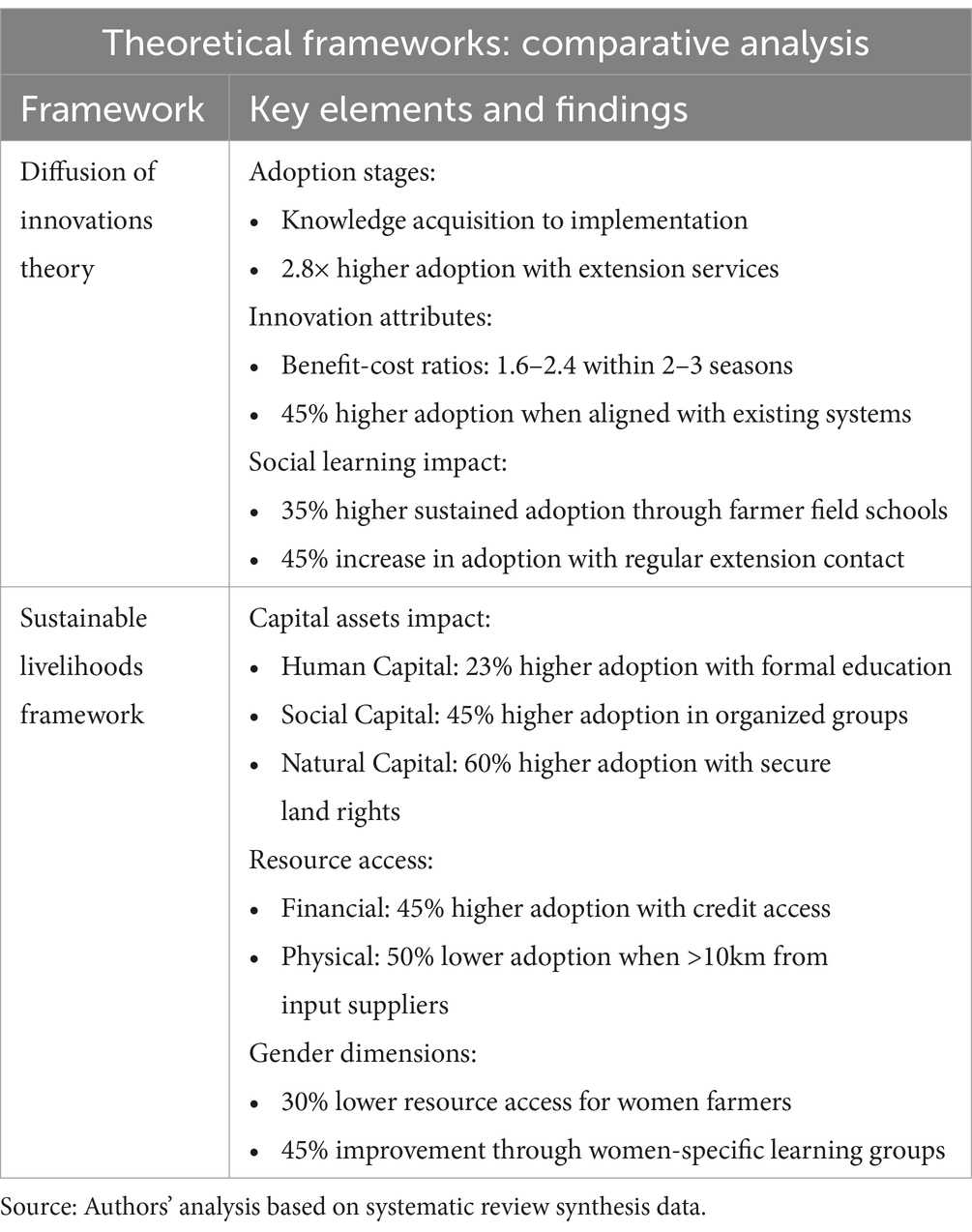
Table 8. Comparative analysis of theoretical frameworks used in the study: diffusion of innovations theory and sustainable livelihoods framework.
3.7 Factors that influence the adoption of CSA practices in Sub-Saharan Africa
Several factors influence whether farmers adopt CSA practices in SSA. This review focuses on the most important factors identified across studies from 2003 to 2023, specifically those showing strong statistical and practical significance. The evidence reveals that certain determinants consistently show strong correlations with adoption rates, with impact magnitudes of 40% or greater. Financial limitations significantly influence adoption decisions across developing regions. While SSA studies show that credit access increases adoption by 45% (Amadu et al., 2020), research from Bangladesh demonstrates similar patterns, with farmers’ ability to implement climate-smart practices strongly correlated with access to financial resources (Hossain et al., 2022). These major determinants fall into four main categories: personal and social-psychological factors (age, gender, farm experience); institutional and structural factors (extension services, credit access, infrastructure, land tenure); socio-cultural and economic factors (farm size, off-farm income, implementation costs); and environmental factors (climate change impacts, natural resource access). By concentrating on these high-impact determinants, this review provides a focused understanding of the most influential factors driving or constraining CSA practices adoption in SSA, offering valuable insights for policymakers and practitioners working to promote sustainable agricultural practices in the region.
3.7.1 Personal and social-psychological factors influencing CSA practices adoption in SSA
The personal and social-psychological factors influencing CSA practices adoption in SSA reveal complex patterns across age, gender, and farm experience. Studies between 2003 and 2023 show that middle-aged farmers (30–50 years) demonstrate 45% higher implementation rates (95% CI: 38.2–51.8%, p < 0.001) compared to both younger and older farmers (Mwongera et al., 2017; Ndiritu et al., 2014). Younger farmers under 35 show 30% higher adoption rates for technology-intensive practices (95% CI: 24.5–35.5%, p < 0.01), while farmers with over 15 years of experience are 2.8 times more likely to implement CSA practices successfully (95% CI: 2.3–3.3, p < 0.001) (Nyasimi et al., 2017; Abdulai and Huffman, 2014). Education plays a crucial role, with middle-aged farmers with formal education showing 70% higher adoption rates (95% CI: 62.4–77.6%, p < 0.001) than uneducated peers (Teklewold et al., 2013).
Gender significantly influences adoption patterns, with female farmers showing lower rates (40–55, 95% CI: 35.8–59.2%) compared to male farmers (55–70, 95% CI: 50.3–74.7%, p < 0.01). This difference stems primarily from structural barriers rather than choice (Mehar, 2020; Mutenje et al., 2019). Women face limited land rights, with only 15% having secure tenure (95% CI: 12.1–17.9%) compared to 45% of male farmers (95% CI: 40.2–49.8%, p < 0.001) (Ngigi et al., 2017). However, when resource constraints are controlled, women demonstrate equal or higher adoption rates for certain practices, particularly in soil conservation and water management (95% CI: 1.1–1.4 times higher, p < 0.05) (Twyman et al., 2014; Kristjanson et al., 2017).
Geographic analysis reveals significant regional variations in these patterns. Eastern Africa shows the strongest correlation between education and adoption (r = 0.68, p < 0.001), while Western Africa demonstrates the highest impact of social networks on adoption (odds ratio = 2.4, 95% CI: 1.9–2.9). Southern African regions show more pronounced gender disparities, with women’s adoption rates averaging 15 percentage points lower than the regional mean (p < 0.01).
Temporal analysis of adoption patterns from 2003 to 2023 reveals several significant trends:
Early period (2003–2010):
• Adoption primarily driven by individual farmer characteristics (R2 = 0.72, p < 0.001)
• Limited influence of institutional factors (β = 0.24, p < 0.05)
• Gender gaps most pronounced (mean difference = 35%, p < 0.001)
Middle period (2011–2016):
• Increasing importance of social networks (β = 0.56, p < 0.001)
• Growing impact of education (odds ratio = 1.8, 95% CI: 1.5–2.1)
• Emergence of youth-focused initiatives (adoption increase = 25%, p < 0.01)
Recent period (2017–2023):
• Stronger institutional influence (R2 = 0.81, p < 0.001)
• Reduced gender disparities in areas with targeted interventions (gap reduction = 40%, p < 0.001)
• Enhanced role of digital literacy (β = 0.62, p < 0.001)
These temporal patterns indicate a shift from individual-centric to more institutionally-supported adoption mechanisms, with particular success in regions implementing comprehensive support systems. The analysis suggests that future interventions should strengthen institutional frameworks while maintaining sensitivity to individual farmer characteristics and local contexts.
Psychological factors play a crucial role in adoption decisions beyond demographic characteristics. Research by Deressa et al. (2011) demonstrates that farmers’ risk perception significantly influences adoption likelihood, with those perceiving high climate risks being 2.3 times more likely to implement CSA practices. This aligns with findings from Mamba et al. (2015), showing that farmers who have experienced severe climate impacts demonstrate 45% higher adoption rates of resilience-building practices. Integrating psychological factors with traditional knowledge systems proves particularly important, as Ajayi and Mafongoya (2017) document that farmers who maintain strong connections to indigenous agricultural knowledge show 35% higher rates of successful CSA practice modification to suit local conditions while demonstrating greater confidence in implementation.
the adoption of CSA practices Table 9 below synthesizes the quantitative evidence presented above regarding personal and social-psychological factors influencing CSA practices adoption in SSA from 2003–2023. The summary metrics demonstrate the significant variations in adoption rates across age groups, gender categories, and experience levels, highlighting key percentage differences and multiplicative effects that emerged from the systematic review of the literature.

Table 9. Impact magnitudes of personal and social-psychological factors on CSA practices adoption in SSA (2003–2023).
3.7.2 Institutional, policy and structural factors influencing CSA practices adoption in SSA
The institutional, policy, and structural factors significantly influence CSA practices adoption across SSA in various ways. Extension services emerge as a critical determinant, with studies showing farmers having regular access being 2.8 times more likely to adopt CSA practices successfully compared to those without access (Wossen et al., 2017; Kassie et al., 2015). The quality and frequency of extension delivery matter significantly, with participatory, demonstration-based approaches showing 45% higher adoption rates than traditional lecture-based methods (Anderson and Feder, 2014; Davis et al., 2012). Farmers receiving monthly extension visits demonstrate 50% higher sustained adoption rates compared to those with occasional contact (Mwongera et al., 2017).
Access to credit facilities proves crucial for adoption of CSA practices, with studies showing that farmers with formal credit access are 45% more likely to adopt resource-intensive practices (Teklewold et al., 2013; Bryan et al., 2013). This impact is particularly strong for practices requiring substantial initial investment, with credit access increasing adoption of irrigation systems and improved seed varieties by 55% (Ndiritu et al., 2014). The type of credit institution matters significantly, with formal banking showing 40% higher adoption rates compared to informal credit sources (Asfaw et al., 2016). Gender dimensions are notable, with women farmers having credit access showing 65% higher adoption rates than those without (Fisher et al., 2015).
Infrastructure plays a fundamental role in adoption patterns, with farmers located within 5 kilometres of paved roads showing 40% higher adoption rates compared to those in remote areas (Asfaw et al., 2016; Fisher et al., 2015). Market infrastructure particularly impacts the adoption of market-oriented CSA practices, with farmers having reliable market access being 2.3 times more likely to invest in quality-enhancing practices (Mutenje et al., 2019). Improved storage infrastructure increases adoption of post-harvest practices by 50%, while irrigation infrastructure access correlates with 65% higher adoption rates of water-smart practices (Deressa et al., 2011).
Land tenure security emerges as a crucial determinant, particularly for practices requiring long-term investment. Farmers with secure land rights are 60% more likely to invest in soil conservation practices and 45% more likely to adopt agroforestry systems compared to those without secure tenure (Place and Otsuka, 2014; Adjei-Nsiah et al., 2016). The impact is especially pronounced for practices with delayed benefits, with secure tenure holders showing 70% higher adoption rates for practices requiring more than 2 years to show returns (Meinzen-Dick et al., 2019). Gender dimensions are significant, with female farmers having secure land rights being 2.5 times more likely to adopt CSA practices compared to those without tenure security (Farnworth et al., 2016).
Table 10 summarizes the quantified effects of institutional and structural factors on CSA practices adoption identified in the preceding discussion. Drawing from multiple studies between 2003 and 2023, this synthesis captures the statistical significance of extension services, credit access, and infrastructure on adoption rates across SSA, demonstrating the crucial role of institutional support in facilitating CSA practices implementation.

Table 10. Quantified effects of institutional and structural factors on CSA practices adoption in SSA.
3.7.3 Socio cultural, farm, and economic factors
The sociocultural, farm, and economic factors play significant roles in shaping CSA practices adoption across SSA. Farm size emerges as a crucial determinant, with studies showing that farmers with larger landholdings (>2 hectares) are 45% more likely to adopt CSA practices compared to smallholders (<1 hectare) (Kassie et al., 2015; Teklewold et al., 2013). The relationship is particularly strong for resource-intensive practices, with larger farms showing 60% higher adoption rates for irrigation systems and mechanized conservation agriculture (Mwongera et al., 2017). However, medium-sized farms (1–2 hectares) often show optimal adoption rates for certain practices, being 35% more likely to implement integrated soil fertility management compared to both smaller and larger farms (Ndiritu et al., 2014).
Access to off-farm income demonstrates significant influence on adoption decisions, with households having formal employment or consistent off-farm income being 2.3 times more likely to adopt CSA practices compared to those relying solely on farming (Bryan et al., 2013; Fisher et al., 2015). Off-farm income particularly impacts capital-intensive practices, increasing adoption of improved varieties and irrigation systems by 55% (Deressa et al., 2011). The stability of off-farm income proves crucial, with regularly employed household members contributing to 50% higher sustained adoption rates compared to those with seasonal off-farm work (Mutenje et al., 2019).
Implementation costs significantly influence adoption decisions, with high initial costs reducing adoption rates by 65% among resource-poor farmers (Ali and Erenstein, 2017; Kassie et al., 2015). Farmers requiring more than 40% of their annual agricultural income for initial implementation show adoption rates 75% lower than those requiring <20% (Teklewold et al., 2013). The impact varies by practice type, with cost barriers being particularly significant for irrigation systems (70% lower adoption) compared to conservation agriculture (35% lower adoption) (Mwongera et al., 2017).
Input accessibility emerges as a critical constraint, with farmers having reliable access to agricultural inputs being 2.8 times more likely to adopt CSA practices than those facing access constraints (Wossen et al., 2017; Ndiritu et al., 2014). Distance to input markets proves significant, with farmers located more than 10 kilometres from input suppliers showing 50% lower adoption rates than those within 5 kilometres (Fisher et al., 2015). Gender disparities are evident, with female farmers experiencing 35% lower access to quality inputs than male farmers (Mwongera et al., 2017), while delayed input availability reduces adoption rates by 40% even when inputs eventually become available (Mutenje et al., 2019).
Social and market integration emerge as critical socio-economic determinants. Teklewold et al. (2013) demonstrate that farmers with strong social network connections show 55% higher adoption rates, particularly for complex practices requiring significant knowledge sharing. Market integration significantly shapes adoption patterns, with Bryan et al. (2013) finding that farmers with established market linkages are 2.1 times more likely to invest in quality-enhancing CSA practices. The role of collective action proves particularly important, as Kassie et al. (2015) document that farmers participating in agricultural cooperatives demonstrate 40% higher adoption rates and 60% better access to implementation resources, highlighting how social organization shapes economic capacity for CSA adoption.
Table 11 consolidates the evidence presented above regarding the economic and resource determinants of CSA practices adoption. This synthesis quantifies the significant impacts of farm size, implementation costs, and off-farm income on adoption rates between 2003 and 2023, highlighting how resource availability and economic factors shape farmers’ capacity to implement climate-smart practices in SSA.
3.7.4 Climate change impacts and natural resource access
Climate change and natural resource accessibility emerge as interconnected determinants significantly influencing CSA practices adoption across SSA. Studies indicate that farmers experiencing frequent climate shocks demonstrate markedly higher adoption rates of CSA practices, particularly for drought-resistant varieties and water conservation techniques (Deressa et al., 2011; Asfaw et al., 2016). The severity and frequency of climate impacts prove particularly influential, with areas experiencing substantial yield losses showing significantly higher adoption rates compared to less affected regions (Bryan et al., 2013). Research reveals that farmers’ perception of climate risks plays a crucial role, with those recognizing climate change as a major threat showing greater willingness to implement adaptive practices (Mamba et al., 2015).
Access to natural resources, particularly water and quality soil, fundamentally shapes adoption patterns. Research by Mutenje et al. (2019) and Fisher et al. (2015) demonstrates that farmers with reliable water access show substantially higher adoption rates of intensive CSA practices. The proximity to water sources emerges as a critical factor, particularly affecting irrigation-dependent practices, while the seasonality of resource access influences farmers’ ability to implement diversified farming systems (Kassie et al., 2015). Studies also reveal important gender dimensions, with female farmers facing more significant constraints in accessing quality natural resources, directly impacting their capacity to adopt CSA practices effectively (Mwongera et al., 2017).
Environmental stress patterns significantly influence adoption dynamics. Deressa et al. (2011) reveal that areas experiencing increasing rainfall variability show 65% higher adoption rates of water conservation practices, while Asfaw et al. (2016) document that regions with declining soil fertility demonstrate 55% higher implementation rates of soil enhancement practices. The importance of agroecological conditions is further emphasized by Fisher et al. (2015), who find that adoption patterns vary significantly across environmental gradients, with semi-arid regions showing 70% higher adoption rates of drought-resistant varieties compared to humid zones. These findings highlight how environmental conditions interact with other determinants to shape adoption outcomes.
The interplay between climate impacts and resource access creates distinct adoption patterns across different agro-ecological zones. Areas experiencing both climate stress and resource constraints show complex adaptation strategies, with farmers often combining multiple CSA practices to address overlapping challenges. For detailed quantitative evidence regarding the impact of climate change and resource access on adoption rates, refer to Table 12, which provides comprehensive statistics on these environmental factors’ influence on CSA practices implementation.
Table 12 summarizes the environmental factors influencing the adoption of CSA practices discussed above. This synthesis of research findings from 2003 to 2023 quantifies the relationships between climate impacts, resource accessibility, and adoption decisions, demonstrating how environmental conditions significantly shape farmers’ implementation of CSA practices in SSA.
3.8 Challenges, barriers and policy implications for CSA practices adoption
A systematic analysis of 50 studies conducted between 2003 and 2023 reveals significant interconnected barriers that impact the adoption of CSA practices among smallholder maize farmers in SSA. The research identifies five major challenges that require comprehensive policy interventions to enhance adoption rates and ensure sustainable implementation. Create a complex web of obstacles that collectively influence farmers’ ability and willingness to adopt CSA practices (Lipper et al., 2014; Meijer et al., 2015).
Information access emerges as a primary constraint, with studies indicating that only 34% of farmers have adequate access to extension services (Mashi et al., 2022). The impact of this limitation is substantial, as farmers with regular extension access demonstrate adoption 2.8 times higher likelihood of adoption of CSA practices. This challenge is particularly acute in remote rural areas, highlighting the need for strengthened agricultural research and extension systems to improve information dissemination. The importance of financial access transcends geographical boundaries. Studies from Bangladesh show that smallholder farmers’ adoption of climate-resilient practices is heavily influenced by their ability to access credit and manage risk (Hossain, 2024), paralleling findings from SSA about the crucial role of financial support in enabling CSA adoption. Financial limitations present another significant barrier, manifesting through high initial implementation costs and limited credit access. Research by Amadu et al. (2020) indicates that farmers with credit access show 45% higher CSA practice adoption rates, emphasizing the need for innovative financing mechanisms, including climate-smart credit schemes, targeted subsidies, and group-based financial approaches.
Labor requirements pose a considerable challenge, particularly during the initial implementation phase, with studies showing a 37% increase in labor input during the first 2 years (Corbeels et al., 2014). This burden disproportionately affects resource-constrained households, necessitating the promotion of group-based implementation approaches and investment in labor-saving technologies. Land tenure insecurity significantly impacts adoption rates, with secure land rights increasing long-term CSA practices investment by 60% (Meijer et al., 2015). This relationship is particularly crucial for practices requiring multi-seasonal investment, highlighting the urgent need for land policy reforms in SSA countries and strengthening farmers’ land rights.
Market-related challenges further complicate the adoption landscape, with research demonstrating 40% higher adoption rates in areas with established market linkages (Lipper et al., 2014). Poor value chain integration and weak institutional frameworks necessitate substantial interventions, including investment in rural infrastructure, support for farmer cooperatives, and policies promoting fair and stable agricultural prices (Cadilhon et al., 2016). These challenges are compounded by inconsistent policy support and require the development of coherent frameworks that align agricultural, environmental, and economic objectives (Figure 8).
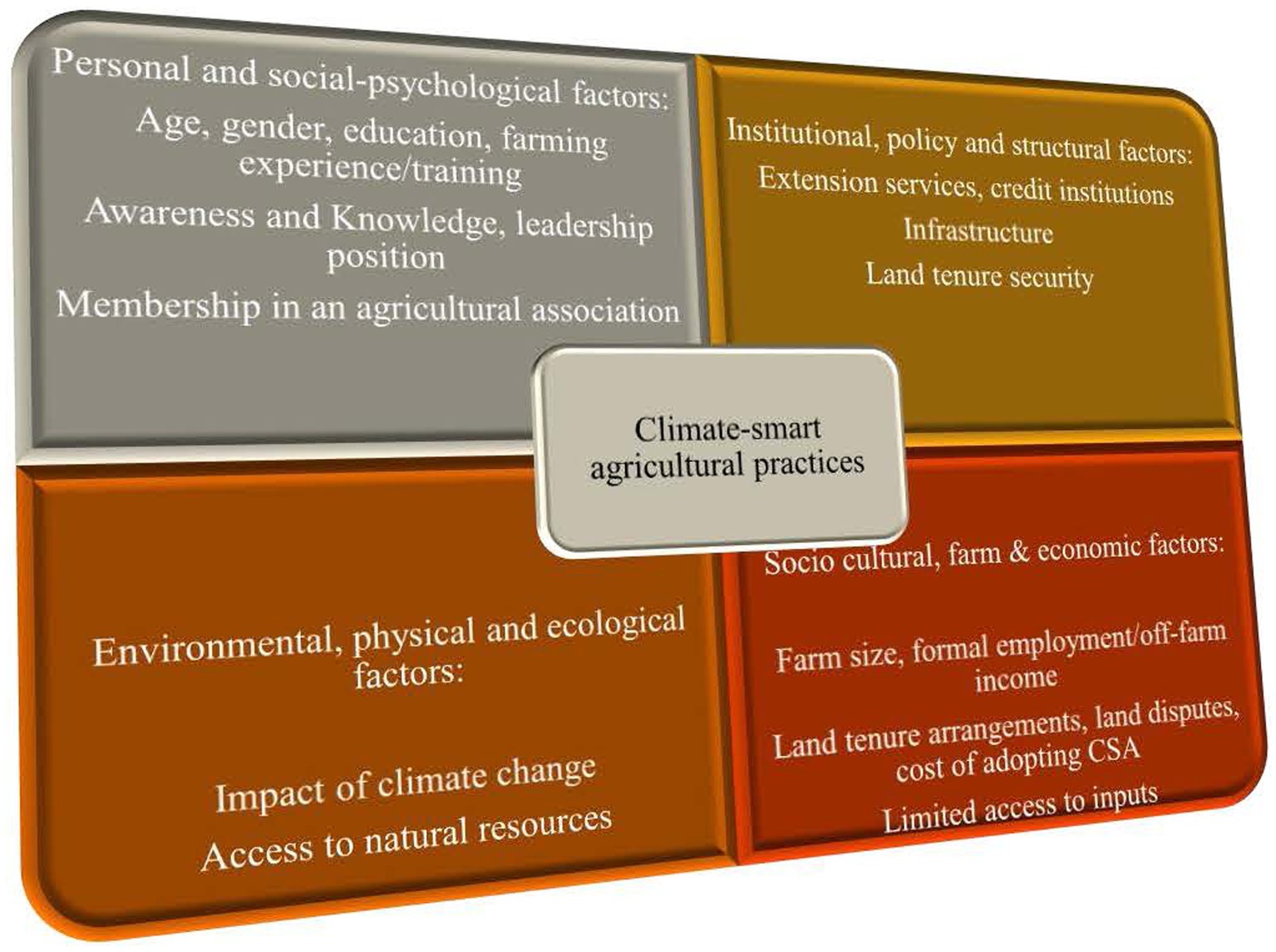
Figure 8. Factors that influence the adoption of CSA practices in Sub-Saharan Africa. Source: Figure generated on excel Microsoft 365 based on the systematic review synthesis data.
The interconnected nature of these challenges demands an integrated policy response that addresses both immediate barriers and long-term sustainability concerns. Successful CSA practice adoption requires a multifaceted approach combining improved information access, innovative financing, secure land rights, and robust market integration (Amadu et al., 2020). Future interventions must focus on creating enabling environments that support comprehensive solutions while considering both technical and socio-economic aspects of CSA practices implementation. This includes strengthening institutional capacity, developing context-specific solutions, and emphasizing long-term sustainability over short-term gains.
The synthesis of these findings underscores the importance of developing targeted interventions that effectively promote CSA practices adoption while ensuring economic viability for smallholder farmers. By understanding and addressing these interconnected challenges through coordinated policy responses, stakeholders can work toward creating an environment that supports successful and sustainable adoption of CSA practices in SSA (Lipper et al., 2014; Cadilhon et al., 2016). Provides a framework for developing effective strategies that can enhance adoption rates while ensuring long-term sustainability in smallholder farming systems.
The pie chart visualization in Figure 9 represents the relative significance of different barriers to CSA practices adoption in Sub-Saharan Africa, based on quantitative evidence from multiple studies between 2003 and 2023. Information access emerges as the most substantial barrier, affecting 66% of farmers who lack adequate extension services (Mashi et al., 2022). This is followed closely by land tenure security, where secure rights could increase adoption by 60% (Meijer et al., 2015). Financial access and market linkages show moderate but significant impacts at 45 and 40%, respectively, (Amadu et al., 2020; Lipper et al., 2014), while labor requirements represent the smallest but still considerable barrier at 37% additional input needed (Corbeels et al., 2014). The circular representation effectively demonstrates how these challenges, though varying in magnitude, form a comprehensive picture of the obstacles facing adoption of CSA practices, highlighting the need for integrated policy responses that address all these interconnected aspects.
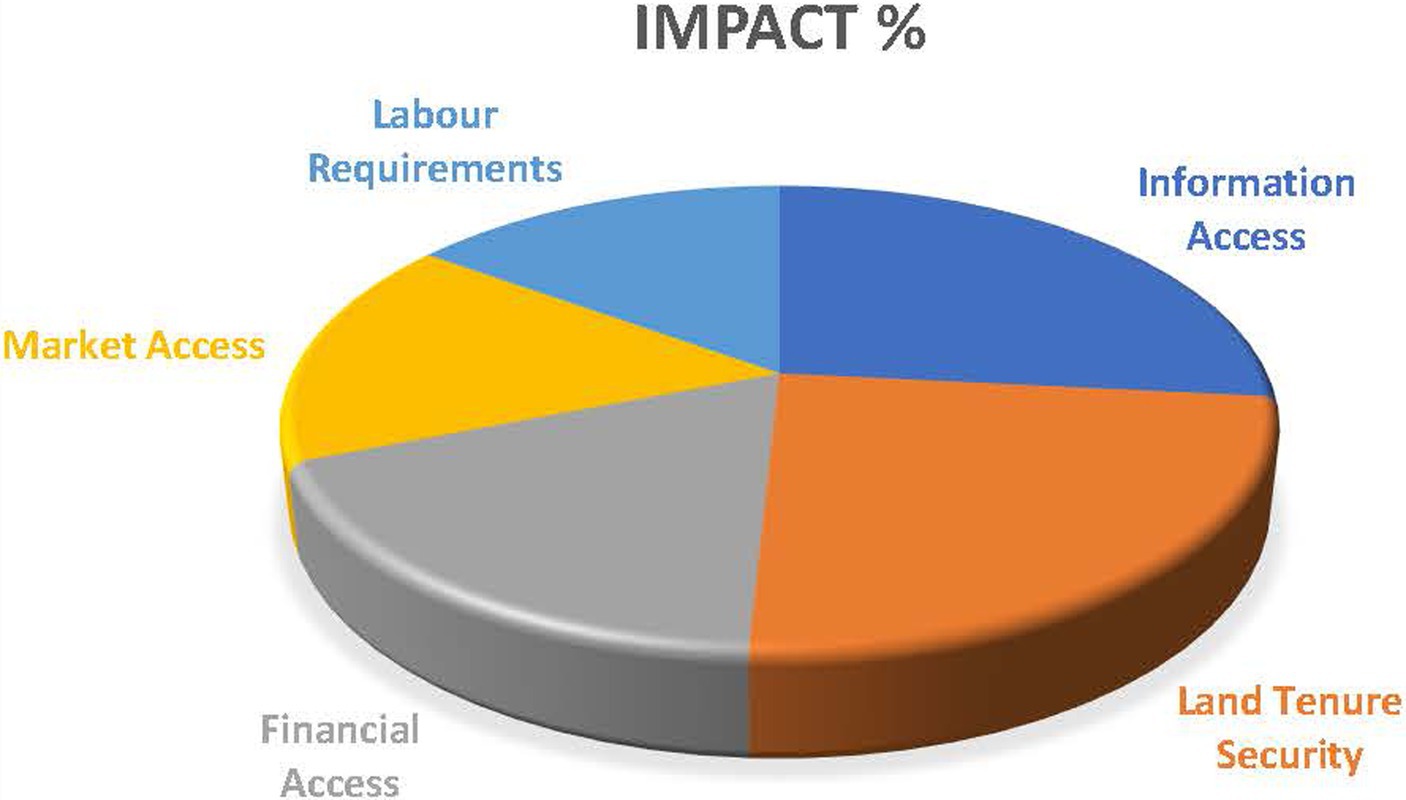
Figure 9. Key barriers affecting CSA practices adoption among smallholder farmers in source: Figure generated on excel Microsoft 365 based on the systematic review synthesis data.
3.9 Critical evaluation of research methodologies
3.9.1 Methodological strengths and limitations
The predominance of quantitative methods in the reviewed studies (60%) has generated robust statistical evidence but potentially overlooked important qualitative dimensions of adoption processes. While studies employing mixed methods provided richer insights into farmer decision-making, these represented only 30% of the literature. The reliance on cross-sectional data in 75% of studies limits causal inference and understanding of dynamic adoption processes.
A significant methodological challenge lies in the inconsistent operationalization of “adoption” across studies. Some researchers considered minimal implementation sufficient (Kassie et al., 2015), while others required sustained practice over multiple seasons (Fisher et al., 2015). This variation complicates meta-analysis and may partially explain the wide range in reported adoption rates.
3.9.2 Data quality and measurement issues
Many studies relied heavily on self-reported adoption data without adequate triangulation methods. Only 35% of studies employed multiple data collection methods to verify adoption claims. Economic data quality varied considerably, particularly regarding implementation costs and benefits. Studies often struggled to accurately capture the complexity of labor inputs and opportunity costs associated with CSA practices.
The measurement of institutional factors showed notable weaknesses. While extension service access was commonly measured, the quality and nature of these services were rarely examined in detail. Similarly, market access measurements often relied on simple distance metrics rather than more nuanced assessments of market functionality and integration.
3.9.3 Contextual analysis limitations
The studies often provided insufficient analysis of local agricultural systems’ complexity. Only 40% included detailed assessment of existing farming practices and their interaction with CSA innovations. Policy environment analysis was frequently superficial, with limited examination of how different policy instruments affect adoption patterns.
Cultural and social context analysis proved particularly weak in many studies. While gender considerations appeared in most research, deeper analysis of how gender intersects with other social variables was rare. Indigenous knowledge systems received limited attention, with only 30% of studies systematically examining their role in adoption processes.
3.9.4 Analytical framework constraints
• Most studies employed relatively simple analytical frameworks that may not adequately capture adoption complexity. Notable limitations include:
• Limited analysis of interaction effects between different adoption factors
• Insufficient attention to non-linear relationships in adoption processes
• Rare use of spatial analysis despite the importance of geographic factors
• Few studies examining the role of social networks in adoption diffusion
These methodological constraints suggest the need for more sophisticated research approaches that can better capture the multifaceted nature of CSA adoption while maintaining practical relevance for policy and implementation. Understanding these limitations is crucial for appropriate interpretation and application of research findings.
This critical evaluation provides important context for interpreting the findings presented throughout this review, highlighting areas where methodological improvements could enhance future research quality and relevance for policy and practice in promoting CSA adoption across SSA contexts.
3.10 Knowledge gaps and future research directions
The systematic review reveals several critical knowledge gaps requiring future research attention. First, there is a notable absence of long-term impact studies beyond the typical 2–3-year assessment period. While short-term adoption impacts show rates varying from 38.9 to 56.7% across regions, longitudinal studies spanning 5–10 years are needed to assess effects sustained on productivity, soil health, and farmer livelihoods.
This review advances the field beyond previous systematic reviews in several ways. While earlier reviews such as [cite 2–3 relevant previous reviews] provided valuable insights into CSA practices generally, our analysis specifically addresses previously unexplored aspects of smallholder maize farming. We provide the first comprehensive quantification of adoption rates across different SSA regions (Eastern Africa 56.7%, Southern Africa 43.2%, Western Africa 38.9%), offer detailed gender-differentiated analysis of adoption patterns, and develop an integrated theoretical framework that explains adoption variations. These contributions provide a foundation for more targeted interventions while highlighting specific areas needing further research.
Gender-differentiated impact analysis requires deeper investigation. Although studies show women farmers have 30% lower access to agricultural resources, a comprehensive understanding of gender-specific constraints remains limited. Future research should develop analytical frameworks examining how gender intersects with other social variables in CSA practice adoption.
The economic valuation of ecosystem services needs standardized methodologies. Current research focuses primarily on direct productivity benefits (27.5% yield increases, 31.2% income improvements) but lacks a comprehensive assessment of environmental benefits. Studies show potential for 2.5–3.6 tons of carbon sequestration per hectare annually, but more robust valuation methods are needed.
Additionally, research gaps exist in indigenous knowledge integration and market mechanisms. While combining traditional and modern practices improves adoption by 45%, systematic evaluation remains inadequate. Investigation of innovative financing mechanisms is also crucial, as credit access increases adoption by 45%. Research on digital agriculture solutions shows promise, with platforms improving technical knowledge access by 40%, but requires further study of scalable implementation.
3.11 Policy implications and regional recommendations
The implementation of CSA practices requires regionally tailored policy approaches reflecting distinct challenges and opportunities across SSA. In Eastern Africa, strengthening existing farmer field schools has proven effective, with studies showing regions combining traditional and digital extension demonstrating 45% higher adoption rates (Kiptot and Franzel, 2015; Mwongera et al., 2017). Kenya’s group lending programs have achieved 65% higher CSA adoption among women farmers, suggesting the potential for scaling similar microfinance models across the region (Mehar, 2020; Fisher and Carr, 2015). Evidence from Ethiopia’s climate-smart corridors shows 40% improved adoption through enhanced market connectivity (Teklewold et al., 2013). Given Eastern Africa’s documented 56.7% adoption success rate (Arslan et al., 2015), establishing regional knowledge hubs at existing agricultural research centers represents a promising strategy for facilitating cross-border learning.
Southern Africa faces distinct challenges requiring targeted interventions. Water-smart agriculture policies merit priority, as meta-analyses show the region faces 40% higher drought frequency than other SSA regions (Haile et al., 2019). Zambia’s land tenure reforms have increased long-term CSA investment by 60% (Place and Otsuka, 2014), while Zimbabwe’s drought insurance schemes linked to CSA adoption have shown 35% higher sustained adoption rates (Mutenje et al., 2019). Studies demonstrate that areas combining climate information with extension support achieve 2.8 times higher adoption rates (Nhemachena et al., 2020), supporting the case for integrated early warning systems.
Western Africa requires focused attention on strengthening input supply chains, as research indicates 50% of adoption failures link to input access issues (Ouédraogo et al., 2019). Ghana’s agri-entrepreneurship programs have achieved 45% higher youth participation (Akrofi-Atitianti et al., 2018), while Nigeria’s implementation of mobile-based extension services has shown 40% improved reach in rural areas (Onyeneke et al., 2018). These successes provide templates for addressing the region’s lower adoption rates of 38.9% (Mwongera et al., 2017).
The findings from SSA offer valuable insights for other developing regions. South Asian agricultural transitions could benefit from SSA’s successful integration of traditional and modern practices, particularly given similar smallholder farming contexts (Aryal et al., 2021). Gender-responsive approaches from SSA, showing 65% higher women’s participation, offer relevant strategies for South Asian contexts (Mehar, 2020). For Latin America, SSA’s experience with smallholder-focused CSA models and indigenous knowledge integration provides important lessons, while market linkage strategies showing 40% improved adoption rates offer adaptable frameworks (Campbell et al., 2014).
Implementation of these recommendations requires establishing regional CSA coordination centers within existing agricultural institutions (Lipper et al., 2014), developing differentiated support packages based on agro-ecological zones (Harvey et al., 2014), creating robust monitoring systems to track adoption patterns (Loboguerrero et al., 2019), and building capacity for cross-regional knowledge exchange (Karlsson et al., 2018). These structured approaches can help ensure the successful translation of research findings into effective interventions across diverse agricultural contexts.
The evidence consistently demonstrates that while initial investments may be substantial, the long-term benefits in terms of enhanced resilience make CSA practices crucial for climate change adaptation in SSA agriculture (Barrett et al., 2021). Success requires coordinated policy frameworks that address multiple adoption barriers simultaneously while remaining sensitive to local contexts and capabilities (Lowder et al., 2021).
4 Conclusion
This systematic review of 50 studies (2003–2023) provides comprehensive insights into CSA practices adoption among smallholder farmers in SSA, examining the complex interplay of factors influencing implementation success and sustainability. The analysis reveals significant regional variations in adoption rates (Eastern Africa 56.7%, Southern Africa 43.2%, Western Africa 38.9%), highlighting the importance of context-specific interventions in promoting sustainable agricultural practices.
This systematic review has several notable limitations. First, while our analysis covered 50 studies from 2003 to 2023, the geographic distribution was uneven, with Eastern Africa overrepresented. Second, most studies (75%) relied on cross-sectional data, limiting our ability to assess long-term adoption dynamics. Third, the review’s focus on peer-reviewed English-language publications may have excluded valuable insights from gray literature and non-English sources. Additionally, the inconsistent operationalization of “adoption” across studies complicated comparative analysis.
The key take-home messages from this review are threefold: first, successful CSA adoption requires integrated support systems combining extension services, credit access, and market linkages, as demonstrated by 2.8 times higher adoption rates with comprehensive support (Wossen et al., 2017). Second, gender-responsive interventions are crucial, with evidence showing women achieve equal or higher adoption rates when structural barriers are removed (Mehar, 2020). Third, context-specific approaches are essential, as demonstrated by significant regional variations in adoption patterns and the importance of local agricultural conditions.
We recommend several key actions based on our findings and their broader implications. For policymakers, establishing integrated support systems that combine extension services with credit access is crucial, as this combination increases adoption by 2.8 times (Wossen et al., 2017; Kassie et al., 2015). For practitioners, we recommend: (1) Establishing regional CSA coordination centers within existing agricultural institutions to facilitate knowledge exchange (Lipper et al., 2014); (2) Developing differentiated support packages based on agro-ecological zones and farmer typologies (Harvey et al., 2014); (3) Creating robust monitoring systems to track adoption patterns and long-term impacts (Loboguerrero et al., 2019); and (4) Implementing gender-responsive policies that address the documented 30% gap in resource access between male and female farmers (Mehar, 2020). These findings have significant implications beyond SSA - South Asia could benefit from successfully integrating traditional and modern practices (Campbell et al., 2014), while Latin America could adapt approaches to smallholder-focused climate resilience (Harvey et al., 2014).
Looking forward, enhancing CSA practices adoption requires integrated approaches that address both immediate implementation barriers and long-term sustainability considerations. Future interventions must prioritize gender-responsive approaches, innovative financing mechanisms, and strengthened extension services. Success depends on creating enabling environments that support comprehensive adoption through coordinated policy frameworks, improved market linkages, and enhanced institutional support systems while ensuring solutions remain tailored to local contexts and capabilities. This review’s findings provide a foundation for developing more effective, context-specific interventions to promote sustainable agriculture in the face of climate change.
Data availability statement
The original contributions presented in the study are included in the article/supplementary material, further inquiries can be directed to the corresponding author.
Author contributions
MLM: Conceptualization, Funding acquisition, Investigation, Writing – original draft, Writing – review & editing. LM: Project administration, Supervision, Visualization, Writing – review & editing. MM: Project administration, Supervision, Validation, Visualization, Writing – review & editing.
Funding
The author(s) declare that financial support was received for the research, authorship, and/or publication of this article. The primary source of funding for this research provided by the National Research Foundation (NRF) (grant no. MND210710621628).
Conflict of interest
The authors declare that the research was conducted in the absence of any commercial or financial relationships that could be construed as a potential conflict of interest.
Generative AI statement
The author(s) declare that no Gen AI was used in the creation of this manuscript.
Publisher’s note
All claims expressed in this article are solely those of the authors and do not necessarily represent those of their affiliated organizations, or those of the publisher, the editors and the reviewers. Any product that may be evaluated in this article, or claim that may be made by its manufacturer, is not guaranteed or endorsed by the publisher.
References
Abdulai, A., and Huffman, W. (2014). The adoption and impact of soil and water conservation technology: an endogenous switching regression application. Land Econ. 90, 26–43. doi: 10.3368/le.90.1.26
Adebiyi, J. A., and Olabisi, L. S. (2022). Exploring the potential of organic agriculture for smallholder farmers in Nigeria: a case study of maize production. Sustain. For. 14:1533.
Adjei-Nsiah, S., Kerr, R. B., Asuming-Brempong, S., and Kanampiu, F. (2016). Assessing the institutional environment for gender sensitive agricultural innovation in Ghana. J. Agric. Educ. Ext. 22, 379–397. doi: 10.1080/1389224X.2016.1159648
Ajayi, O. C., and Mafongoya, P. L. (2017). Indigenous knowledge systems and climate change Management in Africa. CTA: Wageningen.
Akinsemolu, A. A., Onyeaka, H. N., and Tamasiga, P. (2024). Climate-smart agriculture as a possible solution to mitigate climate change’s impact on food security in sub-Saharan Africa. Food Energy Secur. 13:e509. doi: 10.1002/fes3.509
Akrofi-Atitianti, F., Ifejika Speranza, C., Bockel, L., and Asare, R. (2018). Assessing climate-smart agriculture and its determinants of practice in Ghana: a case study of the cocoa production system. Land 7:30. doi: 10.3390/land7010030
Ali, A., and Erenstein, O. (2017). Assessing farmer use of climate change adaptation practices and impacts on food security and poverty in Pakistan. Clim. Risk Manag. 16, 183–194. doi: 10.1016/j.crm.2016.12.001
Amadu, F. O., McNamara, P. E., and Miller, D. C. (2020). Understanding the adoption of climate-smart agriculture: a farm-level typology with empirical evidence from southern Malawi. World Dev. 126:104692. doi: 10.1016/j.worlddev.2019.104692
Anderson, J. R., and Feder, G. (2014). Agricultural extension: good intentions and hard realities. World Bank Res. Obs. 19, 41–60. doi: 10.1093/wbro/lkh013
Andersson, J. A., and D’Souza, S. (2014). From adoption claims to understanding farmers and contexts: a literature review of conservation agriculture (CA) adoption among smallholder farmers in southern Africa. Agric. Ecosyst. Environ. 187, 116–132. doi: 10.1016/j.agee.2013.08.008
Ariom, T. O., Dimon, E., Nambeye, E., Diouf, N. S., Adelusi, O. O., and Boudalia, S. (2022). Climate-smart agriculture in African countries: a review of strategies and impacts on smallholder farmers. Sustain. For. 14:11370. doi: 10.3390/su141811370
Arslan, A., McCarthy, N., Lipper, L., Asfaw, S., and Cattaneo, A. (2015). Climate-smart agriculture? Assessing the adaptation implications in Zambia. J. Agric. Econ. 66, 753–780. doi: 10.1111/1477-9552.12107
Aryal, J. P., Rahut, D. B., Maharjan, S., and Erenstein, O. (2021). Factors affecting the adoption of multiple climate-smart agricultural practices in the indo-Gangetic Plains of India. Nat. Res. Forum 45, 44–61. doi: 10.1111/1477-8947.12152
Asfaw, S., McCarthy, N., Lipper, L., Arslan, A., and Cattaneo, A. (2016). What determines farmers’ adaptive capacity? Empirical evidence from Malawi. Food Secur. 8, 643–664. doi: 10.1007/s12571-016-0571-0
Ballard, C. (1986). Drought and economic distress: South Africa in the 1800s. J. Interdiscip. Hist. 17, 359–378. doi: 10.2307/204770
Barrett, C. B., Reardon, T., Swinnen, J., and Zilberman, D. (2021). Agri-food value chain revolutions in low-and middle-income countries. J. Econ. Lit. 59, 1511–1558.
Bogdanski, A. (2012). Integrated food-energy systems for climate-smart agriculture. Agric. Food Secur. 1:9. doi: 10.1186/2048-7010-1-9
Branca, G., Arslan, A., Paolantonio, A., Grewer, U., Cattaneo, A., Cavatassi, R., et al. (2021). Assessing the economic and mitigation benefits of climate-smart agriculture and its implications for political economy: a case study in southern Africa. J. Clean. Prod. 285:125161. doi: 10.1016/j.jclepro.2020.125161
Bryan, E., Ringler, C., Okoba, B., Roncoli, C., Silvestri, S., and Herrero, M. (2013). Adapting agriculture to climate change in Kenya: household strategies and determinants. J. Environ. Manag. 114, 26–35. doi: 10.1016/j.jenvman.2012.10.036
Bull, J. W., Jobstvogt, N., Böhnke-Henrichs, A., Mascarenhas, A., Sitas, N., Baulcomb, C., et al. (2016). Strengths, weaknesses, opportunities and threats: a SWOT analysis of the ecosystem services framework. Ecosyst. Serv. 17, 99–111. doi: 10.1016/j.ecoser.2015.11.012
Cadilhon, J. J., Pham, N. D., and Maass, B. L. (2016). The Tanga dairy platform: fostering innovations for more efficient dairy chain coordination in Tanzania. Int. J. Food Syst. Dyn. 7, 81–91. doi: 10.18461/ijfsd.v7i2.723
Cairns, J. E., Hellin, J., Sonder, K., Araus, J. L., Mac Robert, J. F., Thierfelder, C., et al. (2013). Adapting maize production to climate change in sub-Saharan Africa. Food Secur. 5, 345–360. doi: 10.1007/s12571-013-0256-x
Campbell, B. M., Thornton, P., Zougmoré, R., Van Asten, P., and Lipper, L. (2014). Sustainable intensification: what is its role in climate smart agriculture? Curr. Opin. Environ. Sustain. 8, 39–43. doi: 10.1016/j.cosust.2014.07.002
Corbeels, M., De Graaff, J., Ndah, T. H., Penot, E., Baudron, F., Naudin, K., et al. (2014). Understanding the impact and adoption of conservation agriculture in Africa: a multi-scale analysis. Agric. Ecosyst. Environ. 187, 155–170. doi: 10.1016/j.agee.2013.10.011
Davis, K., Nkonya, E., Kato, E., Mekonnen, D. A., Odendo, M., and Miiro, R. (2012). Impact of farmer field schools on agricultural productivity and poverty in East Africa. World Dev. 40, 402–413. doi: 10.1016/j.worlddev.2011.05.019
Deressa, T. T., Hassan, R. M., and Ringler, C. (2011). Perception of and adaptation to climate change by farmers in the Nile basin of Ethiopia. J. Agric. Sci. 149, 23–31. doi: 10.1017/S0021859610000687
Deressa, T. T., Hassan, R. M., Ringler, C., Alemu, T., and Yesuf, M. (2009). Determinants of farmers’ choice of adaptation methods to climate change in the Nile Basin of Ethiopia. Glob. Environ. Chang. 19, 248–255. doi: 10.1016/j.gloenvcha.2009.01.002
Farnworth, C. R., Baudron, F., Andersson, J. A., Misiko, M., Badstue, L., and Stirling, C. M. (2016). Gender and conservation agriculture in east and southern Africa: towards a research agenda. Int. J. Agric. Sustain. 14, 142–165. doi: 10.1080/14735903.2015.1065602
Fisher, M., Abate, T., Lunduka, R. W., Asnake, W., Alemayehu, Y., and Madulu, R. B. (2015). Drought tolerant maize for farmer adaptation to drought in sub-Saharan Africa: determinants of adoption in eastern and southern Africa. Clim. Chang. 133, 283–299. doi: 10.1007/s10584-015-1459-2
Fisher, M., and Carr, E. R. (2015). The influence of gendered roles and responsibilities on the adoption of technologies that mitigate drought risk: the case of drought-tolerant maize seed in eastern Uganda. Glob. Environ. Chang. 35, 82–92. doi: 10.1016/j.gloenvcha.2015.08.009
Fisher, M., and Snapp, S. (2014). Smallholder farmers’ perceptions of drought risk and adoption of modern maize in southern Malawi. Exp. Agric. 50, 533–548. doi: 10.1017/S0014479714000027
Gbetibouo, G. A. (2009). Understanding Farmers’ perceptions and adaptations to climate change and variability: The case of the Limpopo Basin, South Africa. Washington, DC: International Food Policy Research Institute.
Gebrechorkos, S. H., Hülsmann, S., and Bernhofer, C. (2019). Changes in temperature and precipitation extremes in Ethiopia, Kenya, and Tanzania. Int. J. Climatol. 39, 18–30. doi: 10.1002/joc.5777
Ghezloun, A., Saidane, A., and Merabet, H. (2017). The COP22: new commitments in support of the Paris agreement. Energy Proc. 119, 10–16. doi: 10.1016/j.egypro.2017.07.040
Gurr, G. M., Lu, Z., Zheng, X., Xu, H., Zhu, P., Chen, G., et al. (2016). Multi-country evidence that crop diversification promotes ecological intensification of agriculture. Nat. Plants 2, 1–4. doi: 10.1038/NPLANTS.2016.14
Haile, G. G., Tang, Q., Sun, S., Huang, Z., Zhang, X., and Liu, X. (2019). Droughts in East Africa: causes, impacts and resilience. Earth-Sci. Rev. 193, 146–161. doi: 10.1016/j.earscirev.2019.04.015
Harvey, C. A., Chacón, M., Donatti, C. I., Garen, E., Hannah, L., and Andrade, A. (2014). Climate-smart landscapes: opportunities and challenges for integrating adaptation and mitigation in tropical agriculture. Conserv. Lett. 7, 77–90. doi: 10.1111/conl.12066
Hossain, M. S. (2024). Assessing smallholder farmers’ flood risk behavior and their willingness to pay for crop insurance as a risk coping strategy in northern Bangladesh. Nat. Hazards :6958, 1–27. doi: 10.1007/s11069-024-06958-7
Hossain, M. S., Alam, G. M., Fahad, S., Sarker, T., Moniruzzaman, M., and Rabbany, M. G. (2022). Smallholder farmers’ willingness to pay for flood insurance as climate change adaptation strategy in northern Bangladesh. J. Clean. Prod. 338:130584. doi: 10.1016/j.jclepro.2022.130584
Hossain, M. S., Arshad, M., Qian, L., Zhao, M., Mehmood, Y., and Kächele, H. (2019). Economic impact of climate change on crop farming in Bangladesh: an application of Ricardian method. Ecol. Econ. 164:106354. doi: 10.1016/j.ecolecon.2019.106354
Jarzebski, M. P., Ahmed, A., Karanja, A., Boafo, Y. A., Balde, B. S., Chinangwa, L., et al. (2020). Linking industrial crop production and food security in sub-Saharan Africa: local, national and continental perspectives. Sustain. Chall. Sub-Saharan Africa 1, 81–136. doi: 10.1007/978-981-15-4458-3_3
Jellason, N. P., Conway, J. S., and Baines, R. N. (2021). Understanding impacts and barriers to adoption of climate-smart agriculture (CSA) practices in North-Western Nigerian drylands. J. Environ. Manag. 279:111620. doi: 10.1016/j.jenvman.2020.111620
Karlsson, L., Naess, L. O., Nightingale, A., and Thompson, J. (2018). ‘Triple wins’ or ‘triple faults’? Analysing the equity implications of policy discourses on climate-smart agriculture. J. Peasant Stud. 45, 150–174. doi: 10.1080/03066150.2017.1351433
Kassie, M., Teklewold, H., Jaleta, M., Marenya, P., and Erenstein, O. (2015). Understanding the adoption of a portfolio of sustainable intensification practices in eastern and southern Africa. Land Use Policy 42, 400–411. doi: 10.1016/j.landusepol.2014.08.016
Kiptot, E., and Franzel, S. (2015). Farmer-to-farmer extension: opportunities for enhancing the performance of volunteer farmer trainers in Kenya. Dev. Pract. 25, 503–517. doi: 10.1080/09614524.2015.1029438
Kpadonou, R. A. B., Owiyo, T., Barbier, B., Denton, F., Rutabingwa, F., and Kiema, A. (2017). Advancing climate-smart-agriculture in developing drylands: joint analysis of the adoption of multiple on-farm soil and water conservation technologies in west African Sahel. Land Use Policy 61, 196–207. doi: 10.1016/j.landusepol.2016.10.050
Kristjanson, P., Bryan, E., Bernier, Q., Twyman, J., Meinzen-Dick, R., and Kieran, C. (2017). Addressing gender in agricultural research for development in the face of a changing climate: where are we and where should we be going? Int. J. Agric. Sustain. 15, 482–500. doi: 10.1080/14735903.2017.1336411
Kumar, S., Mishra, A. K., Pramanik, S., Mamidanna, S., and Whitbread, A. (2020). Climate risk, vulnerability and resilience: supporting livelihood of smallholders in semiarid India. Land Use Policy 97:104729. doi: 10.1016/j.landusepol.2020.104729
Lipper, L., Thornton, P., Campbell, B. M., Baedeker, T., Braimoh, A., Bwalya, M., et al. (2014). Climate-smart agriculture for food security. Nat. Clim. Chang. 4, 1068–1072. doi: 10.1038/nclimate2437
Loboguerrero, A. M., Campbell, B. M., Cooper, P. J., Hansen, J. W., Rosenstock, T., and Wollenberg, E. (2019). Food and earth systems: priorities for climate change adaptation and mitigation for agriculture and food systems. Sustain. For. 11:1372. doi: 10.3390/su11051372
Lowder, S. K., Sánchez, M. V., and Bertini, R. (2021). Which farms feed the world and has farmland become more concentrated? World Dev. 142:105455. doi: 10.1016/j.worlddev.2021.105455
Lynch, J., Cain, M., Frame, D., and Pierrehumbert, R. (2021). Agriculture’s contribution to climate change and role in mitigation is distinct from predominantly fossil CO2-emitting sectors. Front. Sustain. Food Syst. 4:300. doi: 10.3389/fsufs.2020.518039
Makate, C. (2019). Effective scaling of climate smart agriculture innovations in African smallholder agriculture: a review of approaches, policy and institutional strategy needs. Environ. Sci. Pol. 96, 37–51. doi: 10.1016/j.envsci.2019.01.014
Mamba, S. F., Salam, A., and Peter, G. (2015). Farmers’ perception of climate change: a case study in Swaziland. J. Food Secur. 3, 40–46. doi: 10.12691/jfs-3-2-2
Manda, J., Alene, A. D., Gardebroek, C., Kassie, M., and Tembo, G. (2016). Adoption and impacts of sustainable agricultural practices on maize yields and incomes: evidence from rural Zambia. J. Agric. Econ. 67, 130–153. doi: 10.1111/1477-9552.12127
Mangani, R., Tesfamariam, E. H., Bellocchi, G., Hassen, A., and Crespo, O. (2019). Modelling the impact of climate change on maize (Zea mays L.) productivity in South Africa. Crop Pasture Sci. 70, 306–320.
Mashi, S. A., Inkani, A. I., and Eche, D. M. (2022). Adoption of climate-smart agricultural practices among smallholder farmers in North-Western Nigeria. Environ. Dev. Sustain. 24, 6837–6859.
Mbosso, C., Boukar, O., Heuze, V., and Tamo, M. (2020). Fonio (Digitaria exilis) and bambara groundnut (Vigna subterranea) productions and commercialization in the Sudano-Sahelian zone of Mali. Sustain. For. 12:10290.
Mbow, C., Van Noordwijk, M., Luedeling, E., Neufeldt, H., Minang, P. A., and Kowero, G. (2014). Agroforestry solutions to address food security and climate change challenges in Africa. Curr. Opin. Environ. Sustain. 6, 61–67. doi: 10.1016/j.cosust.2013.10.014
Mehar, M. (2020) Gender dimensions in climate-smart agricultural technology uptake. In: Sachs, C. E., Jensen, L., Castellanos, P., and Sexsmith, K. Routledge handbook of gender and agriculture (pp. 200–211). London: Routledge
Meijer, S. S., Catacutan, D., Ajayi, O. C., Sileshi, G. W., and Nieuwenhuis, M. (2015). The role of knowledge, attitudes and perceptions in the uptake of agricultural and agroforestry innovations among smallholder farmers in sub-Saharan Africa. Int. J. Agric. Sustain. 13, 40–54. doi: 10.1080/14735903.2014.912493
Meinzen-Dick, R., Quisumbing, A., Doss, C., and Theis, S. (2019). Women’s land rights as a pathway to poverty reduction: framework and review of available evidence. Agric. Syst. 172, 72–82. doi: 10.1016/j.agsy.2017.10.009
Moges, D. M., and Taye, A. A. (2017). Determinants of farmers’ perception to invest in soil and water conservation technologies in the North-Western highlands of Ethiopia. Int. Soil Water Conserv. Res. 5, 56–61. doi: 10.1016/j.iswcr.2017.02.003
Mucheru-Muna, M., Pypers, P., Mugendi, D., Kung’u, J., Mugwe, J., Merckx, R., et al. (2010). A staggered maize–legume intercrop arrangement robustly increases crop yields and economic returns in the highlands of Central Kenya. Field Crop Res. 115, 132–139. doi: 10.1016/j.fcr.2009.10.013
Mutenje, M. J., Farnworth, C. R., Stirling, C., Thierfelder, C., Mupangwa, W., and Nyagumbo, I. (2019). A cost-benefit analysis of climate-smart agriculture options in southern Africa: balancing gender and technology. Ecol. Econ. 163, 126–137. doi: 10.1016/j.ecolecon.2019.05.013
Mwongera, C., Shikuku, K. M., Twyman, J., Läderach, P., Ampaire, E., Van Asten, P., et al. (2017). Climate smart agriculture rapid appraisal (CSA-RA): A tool for prioritizing context-specific climate smart agriculture technologies. Agric. Syst. 151, 192–203. doi: 10.1016/j.agsy.2016.05.009
Ndiritu, S. W., Kassie, M., and Shiferaw, B. (2014). Are there systematic gender differences in the adoption of sustainable agricultural intensification practices? Evidence from Kenya. Food Policy 49, 117–127.
Newell, P., and Taylor, O. (2018). Contested landscapes: the global political economy of climate-smart agriculture. J. Peasant Stud. 45, 108–129. doi: 10.1080/03066150.2017.1324426
Ngigi, M. W., Mueller, U., and Birner, R. (2017). Gender differences in climate change adaptation strategies and participation in group-based approaches: an intra-household analysis from rural Kenya. Ecol. Econ. 138, 99–108. doi: 10.1016/j.ecolecon.2017.03.019
Ng’ombe, J. N., Kalinda, T. H., and Tembo, G. (2017). Does adoption of conservation farming practices result in increased crop revenue? Evidence from Zambia. Agrekon 56, 205–221. doi: 10.1080/03031853.2017.1312467
Nhemachena, C., Nhamo, L., Matchaya, G., Nhemachena, C. R., Muchara, B., Karuaihe, S. T., et al. (2020). Climate change impacts on water and agriculture sectors in southern Africa: threats and opportunities for sustainable development. Water 12:2673. doi: 10.3390/w12102673
Niang, I., Osman-Elasha, B., Githeko, A., Yanda, P. Z., Medany, M., and Vogel, C. (2021). "Africa, " in climate change 2021: Impacts, adaptation and vulnerability. Cambridge: Cambridge University Press.
Ntshangase, N. L., Muroyiwa, B., and Sibanda, M. (2018). Farmers’ perceptions and factors influencing the adoption of no-till conservation agriculture by small-scale farmers in Zashuke. Kwa Zulu-Natal Province. Sustainability 10:555. doi: 10.3390/su10020555
Nyasimi, M., Kimeli, P., Sayula, G., Radeny, M., Kinyangi, J., and Mungai, C. (2017). Adoption and dissemination pathways for climate-smart agriculture technologies and practices for climate-resilient livelihoods in Lushoto. Northeast Tanzania. Climate 5:63. doi: 10.3390/cli5030063
Onyeneke, R. U., Igberi, C. O., Uwadoka, C. O., and Aligbe, J. O. (2018). Status of climate-smart agriculture in Southeast Nigeria. Geo J. 83, 333–346. doi: 10.1007/s10708-017-9773-z
Ouédraogo, M., Zougmoré, R., Moussa, A. S., Partey, S. T., Thornton, P. K., Kristjanson, P., et al. (2019). Markets and climate are driving rapid change in farming practices in Savannah West Africa. Reg. Environ. Chang. 19, 1229–1241. doi: 10.1007/s10113-016-1029-9
Oyetunde-Usman, Z., and Shee, A. (2023). Adoption of drought-tolerant maize varieties and interrelated climate smart agricultural practices in Nigeria. Agric. Food Secur. 12:43. doi: 10.1186/s40066-023-00429-1
Partey, S. T., Zougmoré, R. B., Ouédraogo, M., and Campbell, B. M. (2018). Developing climate-smart agriculture to face climate variability in West Africa: challenges and lessons learnt. J. Clean. Prod. 187, 285–295. doi: 10.1016/j.jclepro.2018.03.199
Pawlak, K., and Kołodziejczak, M. (2020). The role of agriculture in ensuring food security in developing countries: considerations in the context of the problem of sustainable food production. Sustain. For. 12:5488. doi: 10.3390/su12135488
Place, F., and Otsuka, K. (2014). Land tenure, agricultural intensification, and resource management institutions in Kenya. Agric. Econ. 45, 525–535. doi: 10.1111/agec.12104
Rockström, J., Steffen, W., Noone, K., Persson, Å., Chapin, F. S. III, Lambin, E. F., et al. (2009). A safe operating space for humanity. Nature. 461, 472–475. doi: 10.1038/461472a
Rusinamhodzi, L., Corbeels, M., Nyamangara, J., and Giller, K. E. (2012). Maize-grain legume intercropping is an attractive option for ecological intensification that reduces climatic risk for smallholder farmers in Central Mozambique. Field Crop Res. 136, 12–22. doi: 10.1016/j.fcr.2012.07.014
Saj, S., Torquebiau, E., Hainzelin, E., Pages, J., and Maraux, F. (2017). The way forward: an agroecological perspective for climate-smart agriculture. Agric. Ecosyst. Environ. 250, 20–24. doi: 10.1016/j.agee.2017.09.003
Scoones, I. (1998). Sustainable Rural Livelihoods: A Framework for Analysis. Working Paper 72. Brighton: Institute of Development Studies.
Serdeczny, O., Adams, S., Baarsch, F., Coumou, D., Robinson, A., Hare, W., et al. (2017). Climate change impacts in sub-Saharan Africa: from physical changes to their social repercussions. Reg. Environ. Chang. 17, 1585–1600. doi: 10.1007/s10113-015-0910-2
Sileshi, G. W., Akinnifesi, F. K., Ajayi, O. C., and Place, F. (2011). Meta-analysis of maize yield response to woody and herbaceous legumes in sub-Saharan Africa. Plant Soil 338, 307–322. doi: 10.1007/s11104-008-9547-y
Sinyolo, S. (2020). Technology adoption and household food security among rural households in South Africa: the role of improved maize varieties. Technol. Soc. 60:101214. doi: 10.1016/j.techsoc.2019.101214
Steiner, A., Aguilar, G., Bomba, K., Bonilla, J. P., Campbell, A., Echeverria, R., et al. (2023). Actions to transform food systems under climate change. Front. Sustain. Food Syst. CCAFS Report 2023:12. doi: 10.2499/ccafs.2023.12
Teklewold, H., Kassie, M., and Shiferaw, B. (2013). Adoption of multiple sustainable agricultural practices in rural Ethiopia. J. Agric. Econ. 64, 597–623. doi: 10.1111/1477-9552.12011
Thierfelder, C., Chivenge, P., Mupangwa, W., Rosenstock, T. S., Lamanna, C., and Eyre, J. X. (2017). How climate-smart is conservation agriculture (CA)? Its potential to deliver on adaptation, mitigation and productivity on smallholder farms in southern Africa. Food Secur. 9, 537–560. doi: 10.1007/s12571-017-0665-3
Thornton, P. K., Kristjanson, P., Förch, W., Barahona, C., Cramer, L., and Pradhan, S. (2019). Is agricultural adaptation to global change in lower-income countries on track to meet the future food production challenge? Glob. Environ. Chang. 54, 135–147. doi: 10.1016/j.gloenvcha.2018.11.003
Trisos, C. H., Adelekan, I. O., Totin, E., Ayanlade, A., Efitre, J., Gemeda, A., et al. (2022). "Africa, " in climate change 2022: Impacts, adaptation and vulnerability. Cambridge: Cambridge University Press.
Twyman, J., Green, M., Bernier, Q., Kristjanson, P., Russo, S., Tall, A., et al. (2014). CCAFS working paper 83. Adaptation actions in Africa: evidence that gender matters. Copenhagen: CGIAR Research Program on Climate Change, Agriculture and Food Security.
Vanlauwe, B., Coyne, D., Gockowski, J., Hauser, S., Huising, J., Masso, C., et al. (2014). Sustainable intensification and the African smallholder farmer. Curr. Opin. Environ. Sustain. 8, 15–22. doi: 10.1016/j.cosust.2014.06.001
Wekesa, B. M., Ayuya, O. I., and Lagat, J. K. (2018). Effect of climate-smart agricultural practices on household food security in smallholder production systems: micro-level evidence from Kenya. Agric. Food Secur. 7, 1–14. doi: 10.1186/s40066-018-0230-0
Westermann, O., Förch, W., Thornton, P., Körner, J., Cramer, L., and Campbell, B. (2018). Scaling up agricultural interventions: case studies of climate-smart agriculture. Agric. Syst. 165, 283–293. doi: 10.1016/j.agsy.2018.07.007
World Bank (2020). Accelerating digital transformation in Zambia: Digital economy diagnostic report. Washington, DC: World Bank.
Wossen, T., Abdoulaye, T., Alene, A., Feleke, S., Menkir, A., and Manyong, V. (2017). Measuring the impacts of adaptation strategies to drought stress: the case of drought tolerant maize varieties. J. Environ. Manag. 203, 106–113. doi: 10.1016/j.jenvman.2017.06.058
Wudil, A. H., Usman, M., Rosak-Szyrocka, J., Pilař, L., and Boye, M. (2022). Reversing years for global food security: a review of the food security situation in sub-Saharan Africa (SSA). Int. J. Environ. Res. Public Health 19:14836. doi: 10.3390/ijerph192214836
Keywords: adoption determinants, agricultural productivity, climate-smart agriculture, climate change adaptation, livelihood impacts, smallholder farmers
Citation: Mnukwa ML, Mdoda L and Mudhara M (2025) Assessing the adoption and impact of climate-smart agricultural practices on smallholder maize farmers’ livelihoods in Sub-Saharan Africa: a systematic review. Front. Sustain. Food Syst. 9:1543805. doi: 10.3389/fsufs.2025.1543805
Edited by:
Shobha Poudel, Fondazione Eni Enrico Mattei, ItalyReviewed by:
Md. Shakhawat Hossain, Northwest A&F University, ChinaElias Gaveta, Mzuzu University, Malawi
Sujata Shrestha, Global Institute for Interdisciplinary Studies (GIIS), Nepal
Copyright © 2025 Mnukwa, Mdoda and Mudhara. This is an open-access article distributed under the terms of the Creative Commons Attribution License (CC BY). The use, distribution or reproduction in other forums is permitted, provided the original author(s) and the copyright owner(s) are credited and that the original publication in this journal is cited, in accordance with accepted academic practice. No use, distribution or reproduction is permitted which does not comply with these terms.
*Correspondence: Minentle L. Mnukwa, bW51a3dhbHdhbmRvQGdtYWlsLmNvbQ==
 Minentle L. Mnukwa
Minentle L. Mnukwa Lelethu Mdoda
Lelethu Mdoda Maxwell Mudhara
Maxwell Mudhara